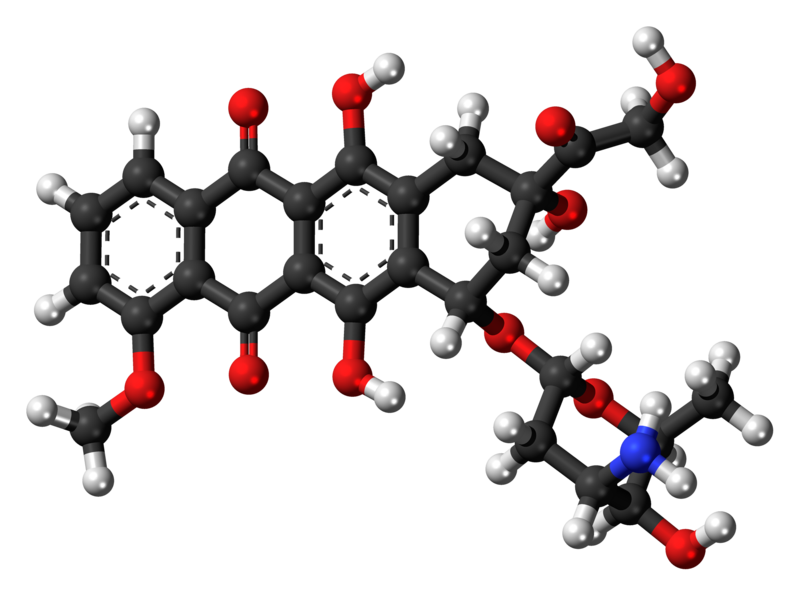Doxorubicin liposome: Difference between revisions
Gerald Chi (talk | contribs) No edit summary |
m (Protected "Doxorubicin liposome": Bot: Protecting all pages from category Drug ([Edit=Allow only administrators] (indefinite) [Move=Allow only administrators] (indefinite))) |
||
| (34 intermediate revisions by 2 users not shown) | |||
| Line 1: | Line 1: | ||
{{ | {{DrugProjectFormSinglePage01 | ||
|authorTag= | |authorTag=<!--Overview--> | ||
|genericName=Doxorubicin liposome | |genericName=Doxorubicin liposome | ||
|aOrAn=an | |aOrAn=an | ||
|drugClass=anthracycline | |drugClass=[[anthracycline]] | ||
|indicationType=treatment | |indicationType=treatment | ||
|indication= | |indication=[[ovarian cancer]], [[AIDS]]-related [[Kaposi's sarcoma]], and [[multiple myeloma]] | ||
|hasBlackBoxWarning=Yes | |hasBlackBoxWarning=Yes | ||
|adverseReactions=[[ | |adverseReactions=[[asthenia]], [[fatigue]], [[fever]], [[stomatitis]], [[nausea]], [[vomiting]], [[diarrhea]], [[constipation]], [[anorexia]], [[hand-foot syndrome]], [[rash]], [[neutropenia]], [[thrombocytopenia]], and [[anemia]] | ||
=== | <!--Black Box Warning--> | ||
|blackBoxWarningTitle=<span style="color:#FF0000;">WARNING: CARDIOMYOPATHY AND INFUSION-RELATED REACTIONS</span> | |||
|blackBoxWarningBody=* Doxil (doxorubicin HCl liposome injection) can cause myocardial damage, including congestive heart failure, as the total cumulative dose of doxorubicin HCl approaches 550 mg/m2. In a clinical study of 250 patients with advanced cancer who were treated with Doxil, the risk of cardiotoxicity was 11% when the cumulative anthracycline dose was between 450–550 mg/m2. Prior use of other anthracyclines or anthracenediones should be included in calculations of total cumulative dosage. The risk of cardiomyopathy may be increased at lower cumulative doses in patients with prior mediastinal irradiation. | |||
* Acute infusion-related reactions consisting of, but not limited to, flushing, shortness of breath, facial swelling, headache, chills, back pain, tightness in the chest or throat, and/or hypotension occurred in 11% of patients with solid tumors treated with Doxil. Serious, life-threatening and fatal infusion reactions have been reported. | |||
<!--Adult Indications and Dosage--> | |||
==== | <!--FDA-Labeled Indications and Dosage (Adult)--> | ||
|fdaLIADAdult=====Indications==== | |||
=== | ======Ovarian Cancer====== | ||
Doxil is indicated for the treatment of patients with [[ovarian cancer]] whose disease has progressed or recurred after [[List of chemotherapeutic agents#Platinum coordination complexes|platinum-based chemotherapy]]. | |||
==== | ======AIDS-Related Kaposi's Sarcoma====== | ||
Doxil is indicated for the treatment of [[AIDS]]-related [[Kaposi's sarcoma]] in patients after failure of prior systemic [[chemotherapy]] or intolerance to such therapy. | |||
==== | ======Multiple Myeloma====== | ||
Doxil, in combination with [[bortezomib]], is indicated for the treatment of patients with [[multiple myeloma]] who have not previously received [[bortezomib]] and have received at least one prior therapy. | |||
====Dosage==== | |||
==== Dosage | |||
=====Important Use Information===== | |||
Do not | Do not substitute Doxil for [[doxorubicin|doxorubicin HCl]] injection. | ||
Do not administer as an undiluted suspension or as an [[intravenous]] bolus. | |||
=====Ovarian Cancer===== | |||
The recommended dose of Doxil is 50 mg/m2 intravenously over 60 minutes every 28 days until disease progression or unacceptable toxicity. | |||
=====AIDS-Related Kaposi's Sarcoma===== | |||
The recommended dose of Doxil is 20 mg/m2 intravenously over 60 minutes every 21 days until disease progression or unacceptable toxicity. | |||
=====Multiple Myeloma===== | |||
The recommended dose of Doxil is 30 mg/m2 intravenously over 60 minutes on day 4 of each 21-day cycle for eight cycles or until disease progression or unacceptable toxicity. Administer Doxil after bortezomib on day 4 of each cycle. | |||
=====Dose Modifications for Adverse Reactions===== | |||
Dose | |||
Do not increase Doxil after a dose reduction for toxicity. | |||
[[File:Doxil table01.png|thumb|none|400px|This image is provided by the National Library of Medicine.]] | |||
[[File:Doxil table02.png|thumb|none|400px|This image is provided by the National Library of Medicine.]] | |||
[[ | For [[neuropathic pain]] or [[peripheral neuropathy]], no dosage adjustments are required for Doxil. Refer to [[bortezomib]] manufacturer's prescribing information. | ||
=====Preparation and Administration===== | |||
======Preparation====== | |||
Dilute Doxil doses up to 90 mg in 250 mL of 5% Dextrose Injection, USP prior to administration. Dilute doses exceeding 90 mg in 500 mL of 5% Dextrose Injection, USP prior to administration. Refrigerate diluted Doxil at 2°C to 8°C (36°F to 46°F) and administer within 24 hours. | |||
======Administration====== | |||
Parenteral drug products should be inspected visually for particulate matter and discoloration prior to administration, whenever solution and container permit. Do not use if a precipitate or foreign matter is present. | |||
Do not use with in-line filters. | |||
Administer the first dose of Doxil at an initial rate of 1 mg/min. If no infusion-related adverse reactions are observed, increase the infusion rate to complete the administration of the drug over one hour. Do not rapidly flush the infusion line. | |||
Do not mix Doxil with other drugs. | |||
Management of Suspected Extravasation | |||
Discontinue Doxil for burning or stinging sensation or other evidence indicating perivenous infiltration or [[extravasation]]. Manage confirmed or suspected extravasation as follows: | |||
* Do not remove the needle until attempts are made to aspirate extravasated fluid | |||
* Do not flush the line | |||
* Avoid applying pressure to the site | |||
* Apply ice to the site intermittently for 15 min 4 times a day for 3 days | |||
* If the extravasation is in an extremity, elevate the extremity | |||
=====Procedure for Proper Handling and Disposal===== | |||
Handle and dispose of Doxil in accordance with recommendations for the handling and disposal of hazardous drugs. | |||
If Doxil comes into contact with skin or mucosa, immediately wash thoroughly with soap and water. | |||
<!--Off-Label Use and Dosage (Adult)--> | |||
<!--Guideline-Supported Use (Adult)--> | |||
|offLabelAdultGuideSupport=<SMALL>There is limited information regarding <i>Off-Label Guideline-Supported Use</i> of {{PAGENAME}} in adult patients.</SMALL> | |||
<!--Non–Guideline-Supported Use (Adult)--> | |||
|offLabelAdultNoGuideSupport======Mycosis fungoides===== | |||
* Dosing Information | |||
==== | :* In observational, single-arm studies, pegylated liposomal DOXOrubicin 20 to 40 mg/m(2) IV every 4 weeks was administered for patients with refractory [[mycosis fungoides]].<ref>{{Cite journal| issn = 1592-8721| volume = 92| issue = 5| pages = 686–689| last1 = Pulini| first1 = Stefano| last2 = Rupoli| first2 = Serena| last3 = Goteri| first3 = Gaia| last4 = Pimpinelli| first4 = Nicola| last5 = Alterini| first5 = Renato| last6 = Tassetti| first6 = Angela| last7 = Scortechini| first7 = Anna Rita| last8 = Offidani| first8 = Massimo| last9 = Mulattieri| first9 = Simonetta| last10 = Stronati| first10 = Andrea| last11 = Brandozzi| first11 = Giuliano| last12 = Giacchetti| first12 = Alfredo| last13 = Mozzicafreddo| first13 = Giorgio| last14 = Ricotti| first14 = Giuseppe| last15 = Filosa| first15 = Giorgio| last16 = Bettacchi| first16 = Alberta| last17 = Simonacci| first17 = Marco| last18 = Novelli| first18 = Nicolino| last19 = Leoni| first19 = Pietro| title = Pegylated liposomal doxorubicin in the treatment of primary cutaneous T-cell lymphomas| journal = Haematologica| date = 2007-05| pmid = 17488695}}</ref><ref>{{Cite journal| doi = 10.1001/archderm.144.6.727| issn = 1538-3652| volume = 144| issue = 6| pages = 727–733| last1 = Quereux| first1 = Gaëlle| last2 = Marques| first2 = Sonia| last3 = Nguyen| first3 = Jean-Michel| last4 = Bedane| first4 = Christophe| last5 = D'incan| first5 = Michel| last6 = Dereure| first6 = Olivier| last7 = Puzenat| first7 = Elisabeth| last8 = Claudy| first8 = Alain| last9 = Martin| first9 = Ludovic| last10 = Joly| first10 = Pascal| last11 = Delaunay| first11 = Michele| last12 = Beylot-Barry| first12 = Marie| last13 = Vabres| first13 = Pierre| last14 = Celerier| first14 = Philippe| last15 = Sasolas| first15 = Bruno| last16 = Grange| first16 = Florent| last17 = Khammari| first17 = Amir| last18 = Dreno| first18 = Brigitte| title = Prospective multicenter study of pegylated liposomal doxorubicin treatment in patients with advanced or refractory mycosis fungoides or Sézary syndrome| journal = Archives of Dermatology| date = 2008-06| pmid = 18559761}}</ref> | ||
<!--Pediatric Indications and Dosage--> | |||
= | <!--FDA-Labeled Indications and Dosage (Pediatric)--> | ||
|fdaLIADPed=The safety and effectiveness of Doxil in pediatric patients have not been established. | |||
<!--Off-Label Use and Dosage (Pediatric)--> | |||
= | <!--Guideline-Supported Use (Pediatric)--> | ||
|offLabelPedGuideSupport=<SMALL>There is limited information regarding <i>Off-Label Guideline-Supported Use</i> of {{PAGENAME}} in pediatric patients.</SMALL> | |||
<!--Non–Guideline-Supported Use (Pediatric)--> | |||
|offLabelPedNoGuideSupport=<SMALL>There is limited information regarding <i>Off-Label Non–Guideline-Supported Use</i> of {{PAGENAME}} in pediatric patients.</SMALL> | |||
= | <!--Contraindications--> | ||
|contraindications=Doxil is contraindicated in patients who have a history of severe [[hypersensitivity]] reactions, including [[anaphylaxis]], to doxorubicin HCl. | |||
<!--Warnings--> | |||
|warnings======Cardiomyopathy===== | |||
Doxorubicin HCl can result in myocardial damage, including acute left ventricular failure. The risk of [[cardiomyopathy]] with doxorubicin HCl is generally proportional to the cumulative exposure. The relationship between cumulative Doxil dose and the risk of cardiac toxicity has not been determined. | |||
In a clinical study in 250 patients with advanced cancer who were treated with Doxil, the risk of cardiotoxicity was 11% when the cumulative anthracycline dose was between 450–550 mg/m2. Cardiotoxicity was defined as >20% decrease in resting left ventricular ejection fraction (LVEF) from baseline where [[LVEF]] remained in the normal range or a >10% decrease in LVEF from baseline where LVEF was less than the institutional lower limit of normal. Two percent of patients developed signs and symptoms of congestive heart failure without documented evidence of cardiotoxicity. | |||
Assess left ventricular cardiac function (e.g. MUGA or [[echocardiogram]] prior to initiation of Doxil, during treatment to detect acute changes, and after treatment to detect delayed cardiotoxicity. Administer Doxil to patients with a history of cardiovascular disease only when the potential benefit of treatment outweighs the risk. | |||
=====Infusion-Related Reactions===== | |||
Serious and sometimes life-threatening infusion-related reactions characterized by one or more of the following symptoms can occur with Doxil: [[flushing]], [[shortness of breath]] facial swelling, [[headache]], [[chills]], [[chest pain]], [[back pain]], tightness in the chest and throat, [[fever]], [[tachycardia]], [[pruritus]], [[rash]], [[cyanosis]], [[syncope]], [[bronchospasm]], [[asthma]], [[apnea]], and [[hypotension]]. The majority of infusion-related events occurred during the first infusion. Of 239 patients with ovarian cancer treated with Doxil in Trial 4, 7% of patients experienced acute infusion-related reactions resulting in dose interruption. All occurred during cycle 1 and none during subsequent cycles. Across multiple studies of Doxil monotherapy including this and other studies enrolling 760 patients with various solid tumors, 11% of patients had infusion-related reactions. | |||
Ensure that medications to treat infusion-related reactions and cardiopulmonary resuscitative equipment is available for immediate use prior to initiation of Doxil. Initiate Doxil infusions at a rate of 1 mg/min and increase rate as tolerated. In the event of an infusion-related reaction, temporarily stop the drug until resolution then resume at a reduced infusion rate. Discontinue Doxil infusion for serious or life-threatening infusion-related reactions. | |||
==== | =====Hand-Foot Syndrome (HFS)===== | ||
In Trial 4, the incidence of HFS was 51% of patients in the Doxil arm and 0.9% of patients in the topotecan arm, including 24% Grade 3 or 4 cases of HFS in Doxil-treated patients and no Grade 3 or 4 cases in topotecan-treated patients. HFS or other skin toxicity required discontinuation of Doxil in 4.2% of patients. | |||
HFS was generally observed after 2 or 3 cycles of treatment but may occur earlier. Delay Doxil for the first episode of Grade 2 or greater HFS. Discontinue Doxil if HFS is severe and debilitating. | |||
=====Secondary Oral Neoplasms===== | |||
Secondary oral cancers, primarily squamous cell carcinoma, have been reported from post-marketing experience in patients with long-term (more than one year) exposure to Doxil. These malignancies were diagnosed both during treatment with Doxil and up to 6 years after the last dose. Examine patients at regular intervals for the presence of oral ulceration or with any oral discomfort that may be indicative of secondary oral cancer. | |||
The altered pharmacokinetics and preferential tissue distribution of liposomal doxorubicin that contributes to enhanced skin toxicity and [[mucositis]] compared to free doxorubicin may play a role in the development of oral secondary malignancies with long-term use. | |||
=====Embryofetal Toxicity===== | |||
Based on animal data, Doxil can cause fetal harm when administered to a pregnant woman. At doses approximately 0.12 times the recommended clinical dose, Doxil was embryotoxic and abortifacient in rabbits. Advise pregnant women of the potential risk to a fetus. Advise females and males of reproductive potential to use effective contraception during and for 6 months after treatment with Doxil. | |||
<!--Adverse Reactions--> | |||
<!--Clinical Trials Experience--> | |||
|clinicalTrials=The most common adverse reactions (>20%) observed with Doxil are asthenia, fatigue, fever, nausea, stomatitis, vomiting, diarrhea, constipation, anorexia, hand-foot syndrome, rash and neutropenia, thrombocytopenia and anemia. | |||
=====Adverse Reactions in Clinical Trials===== | |||
Because clinical trials are conducted under widely varying conditions, the adverse reaction rates observed cannot be directly compared to rates on other clinical trials and may not reflect the rates observed in clinical practice. | |||
The safety data reflect exposure to Doxil in 1310 patients including: 239 patients with ovarian cancer, 753 patients with AIDS-related Kaposi's sarcoma, and 318 patients with [[multiple myeloma]]. | |||
The following tables present adverse reactions from clinical trials of single-agent Doxil in ovarian cancer and AIDS-Related [[Kaposi's sarcoma]]. | |||
=====Patients With Ovarian Cancer===== | |||
The safety data described below are from Trial 4, which included 239 patients with ovarian cancer treated with Doxil 50 mg/m2 once every 4 weeks for a minimum of four courses in a randomized, multicenter, open-label study. In this trial, patients received Doxil for a median number of 3.2 months (range 1 day to 25.8 months). The median age of the patients is 60 years (range 27 to 87), with 91% Caucasian, 6% Black, and 3% Hispanic or Other. | |||
Table 3 presents the hematologic adverse reactions from Trial 4. | |||
[[File:Doxil table03.png|thumb|none|400px|This image is provided by the National Library of Medicine.]] | |||
Table 4 presents the non-hematologic adverse reactions from Trial 4. | |||
[[File:Doxil table04.png|thumb|none|400px|This image is provided by the National Library of Medicine.]] | |||
The following additional adverse reactions were observed in patients with ovarian cancer with doses administered every four weeks (Trial 4). | |||
==== | ======Incidence 1% to 10%====== | ||
Cardiovascular: [[vasodilation]], [[tachycardia]], [[deep vein thrombosis]], [[hypotension]], [[cardiac arrest]]. | |||
Digestive: oral [[moniliasis]], mouth [[ulceration]], [[esophagitis]], [[dysphagia]], [[rectal bleeding]], [[ileus]]. | |||
Hematologic and Lymphatic: [[ecchymosis]]. | |||
Metabolic and Nutritional: [[dehydration]], [[weight loss]], [[hyperbilirubinemia]], [[hypokalemia]], [[hypercalcemia]], [[hyponatremia]]. | |||
Nervous: [[somnolence]], [[dizziness]], [[depression]]. | |||
Respiratory: [[rhinitis]], [[pneumonia]], [[sinusitis]], [[epistaxis]]. | |||
Skin and Appendages: [[pruritus]], skin [[discoloration]], vesiculobullous [[rash]], maculopapular rash, [[exfoliative dermatitis]], [[herpes zoster]], dry skin, [[herpes simplex]], [[fungal]] [[dermatitis]], [[furunculosis]], [[acne]]. | |||
Special Senses: [[conjunctivitis]], taste perversion, dry eyes. | |||
Urinary: [[urinary tract infection]], [[hematuria]], vaginal moniliasis. | |||
=====Patients With AIDS-Related Kaposi's Sarcoma===== | |||
The safety data described is based on the experience reported in 753 patients with AIDS-related Kaposi's sarcoma (KS) enrolled in four open-label, uncontrolled trials of Doxil administered at doses ranging from 10 to 40 mg/m2 every 2 to 3 weeks. Demographics of the population were: median age 38.7 years (range 24–70); 99% male; 88% Caucasian, 6% Hispanic, 4% Black, and 2% Asian/other/unknown. The majority of patients were treated with 20 mg/m2 of Doxil every 2 to 3 weeks with a median exposure of 4.2 months (range 1 day to 26.6 months). The median cumulative dose was 120 mg/m2 (range 3.3 to 798.6 mg/m2); 3% received cumulative doses of greater than 450 mg/m2. | |||
Disease characteristics were: 61% poor risk for KS tumor burden, 91% poor risk for immune system, and 47% poor risk for systemic illness; 36% were poor risk for all three categories; median CD4 count 21 cells/mm3 (51% less than 50 cells/mm3); mean absolute neutrophil count at study entry approximately 3,000 cells/mm3. | |||
Of the 693 patients with concomitant medication information, 59% were on one or more antiretroviral medications [35% [[zidovudine]] (AZT), 21% [[didanosine]] (ddI), 16% [[zalcitabine]] (ddC), and 10% [[stavudine]] (D4T)]; 85% received PCP prophylaxis (54% [[sulfamethoxazole]]/[[trimethoprim]]); 85% received antifungal medications (76% [[fluconazole]]); 72% received antivirals (56% [[acyclovir]], 29% [[ganciclovir]], and 16% [[foscarnet]]) and 48% patients received colony-stimulating factors ([[sargramostim]]/[[filgrastim]]) during their course of treatment. | |||
Adverse reactions led to discontinuation of treatment in 5% of patients with AIDS-related Kaposi's sarcoma and included [[myelosuppression]], cardiac adverse reactions, infusion-related reactions, [[toxoplasmosis]], [[HFS]], [[pneumonia]], [[cough]]/[[dyspnea]], [[fatigue]], [[optic neuritis]], progression of a non-KS tumor, allergy to [[penicillin]], and unspecified reasons. Tables 5 and 6 summarize adverse reactions reported in patients treated with Doxil for AIDS-related Kaposi's sarcoma in a pooled analysis of the four trials. | |||
[[File:Doxil table05.png|thumb|none|400px|This image is provided by the National Library of Medicine.]] | |||
[[File:Doxil table06.png|thumb|none|400px|This image is provided by the National Library of Medicine.]] | |||
The following additional adverse reactions were observed in 705 patients with AIDS-related Kaposi's sarcoma. | |||
======Incidence 1% to 5%====== | |||
Body as a Whole: [[headache]], [[back pain]], [[infection]], [[allergic reaction]], [[chills]]. | |||
Cardiovascular: [[chest pain]], [[hypotension]], [[achycardia]]. | |||
Cutaneous: [[herpes simplex]], [[rash]], [[itching]]. | |||
Digestive: mouth [[ulceration]], [[anorexia]], [[dysphagia]]. | |||
Metabolic and Nutritional: [[SGPT]] increase, [[weight loss]], [[hyperbilirubinemia]]. | |||
Other | Other: [[dyspnea]], [[pneumonia]], [[dizziness]], [[somnolence]]. | ||
======Incidence Less Than 1%====== | |||
Body As A Whole: [[sepsis]], [[moniliasis]], [[cryptococcosis]]. | |||
Cardiovascular: [[thrombophlebitis]], [[cardiomyopathy]], [[palpitation]], [[bundle branch block]], [[congestive heart failure]], [[heart arrest]], [[thrombosis]], [[ventricular arrhythmia]]. | |||
Digestive: [[hepatitis]]. | |||
Metabolic and Nutritional Disorders: [[dehydration]] | |||
Respiratory: [[cough]] increase, [[pharyngitis]]. | |||
Skin and Appendages: maculopapular [[rash]], [[herpes zoster]]. | |||
Special Senses: taste perversion, [[conjunctivitis]]. | |||
=====Patients With Multiple Myeloma===== | |||
The safety data described are from 318 patients treated with Doxil (30 mg/m2) administered on day 4 following bortezomib (1.3 mg/m2 i.v. bolus on days 1, 4 , 8 and 11) every 3 weeks, in a randomized, open-label, multicenter study (Trial 6). In this trial, patients in the Doxil + bortezomib combination group were treated for a median number of 4.5 months (range 21 days to 13.5 months). The population was 28 to 85 years of age (median age 61), 58% male, 90% Caucasian, 6% Black, and 4% Asian and Other. Table 7 lists adverse reactions reported in 10% or more of patients treated with Doxil in combination with [[bortezomib]] for [[multiple myeloma]]. | |||
[[File:Doxil table06.png|thumb|none|400px|This image is provided by the National Library of Medicine.]] | |||
|postmarketing= | <!--Postmarketing Experience--> | ||
|postmarketing=The following additional adverse reactions have been identified during post approval use of Doxil. Because these reactions are reported voluntarily from a population of uncertain size, it is not always possible to reliably estimate their frequency or establish a causal relationship to drug exposure. | |||
Musculoskeletal and Connective Tissue Disorders: [[muscle spasms]] | |||
Respiratory, Thoracic and Mediastinal Disorders: [[pulmonary embolism]] (in some cases fatal) | |||
Hematologic disorders: Secondary [[acute myelogenous leukemia]] | |||
Skin and subcutaneous tissue disorders: [[erythema multiforme]], [[Stevens-Johnson syndrome]], [[toxic epidermal necrolysis]] | |||
<!--Drug Interactions--> | |||
|drugInteractions=No formal drug interaction studies have been conducted with Doxil. | |||
<!--Use in Specific Populations--> | |||
|useInPregnancyFDA======Risk Summary===== | |||
Based on findings in animals, Doxil can cause fetal harm when administered to a pregnant woman. In animal reproduction studies, Doxil was embryotoxic in rats and abortifacient in rabbits following intravenous administration during organogenesis at doses approximately 0.12 times the recommended clinical dose. There are no available human data informing the drug-associated risk. Advise pregnant women of the potential risk to a fetus. | |||
The background risk of major birth defects and miscarriage for the indicated populations are unknown. However, the background risk in the U.S. general population of major birth defects is 2–4% and of miscarriage is 15–20% of clinically recognized pregnancies. | |||
=====Animal Data===== | |||
Doxil was embryotoxic at doses of 1 mg/kg/day in rats and was embryotoxic and abortifacient at 0.5 mg/kg/day in rabbits (both doses are about 0.12 times the recommended dose of 50 mg/m2 human dose on a mg/m2 basis). Embryotoxicity was characterized by increased embryo-fetal deaths and reduced live litter sizes. | |||
|useInLaborDelivery=<SMALL>There is no FDA guidance on use of {{PAGENAME}} during labor and delivery.</SMALL> | |||
|useInNursing=It is not known whether Doxil is present in human milk. Because many drugs, including anthracyclines, are excreted in human milk and because of the potential for serious adverse reactions in nursing infants from Doxil, discontinue breastfeeding during treatment with Doxil. | |||
|useInPed=The safety and effectiveness of Doxil in pediatric patients have not been established. | |||
|useInGeri=Clinical studies of Doxil conducted in patients with either epithelial ovarian cancer (Trial 4) or with AIDS-related Kaposi's sarcoma (Trial 5) did not contain sufficient numbers of patients aged 65 and over to determine whether they respond differently from younger subjects. | |||
In Trial 6, of 318 patients treated with Doxil in combination with bortezomib for multiple myeloma, 37% were 65 years of age or older and 8% were 75 years of age or older. No overall differences in safety or efficacy were observed between these patients and younger patients. | |||
|useInGender======Contraception===== | |||
======Females====== | |||
Doxil can cause fetal harm when administered to a pregnant woman. Advise females of reproductive potential to use effective contraception during and for 6 months after treatment with Doxil. | |||
|alcohol=Alcohol- | ======Males====== | ||
Doxil may damage spermatozoa and testicular tissue, resulting in possible genetic fetal abnormalities. Males with female sexual partners of reproductive potential should use effective contraception during and for 6 months after treatment with Doxil. | |||
=====Infertility===== | |||
======Females====== | |||
In females of reproductive potential, Doxil may cause infertility and result in amenorrhea. Premature menopause can occur with doxorubicin HCl. Recovery of menses and ovulation is related to age at treatment. | |||
======Males====== | |||
Doxil may result in oligospermia, azoospermia, and permanent loss of fertility. Sperm counts have been reported to return to normal levels in some men. This may occur several years after the end of therapy. | |||
|useInRace=<SMALL>There is no FDA guidance on the use of {{PAGENAME}} with respect to specific racial populations.</SMALL> | |||
|useInRenalImpair=<SMALL>There is no FDA guidance on the use of {{PAGENAME}} in patients with renal impairment.</SMALL> | |||
|useInHepaticImpair=The pharmacokinetics of Doxil has not been adequately evaluated in patients with hepatic impairment. Doxorubicin is eliminated in large part by the liver. Reduce Doxil for serum bilirubin of 1.2 mg/dL or higher. | |||
|useInReproPotential=<SMALL>There is no FDA guidance on the use of {{PAGENAME}} in women of reproductive potentials and males.</SMALL> | |||
|useInImmunocomp=<SMALL>There is no FDA guidance one the use of {{PAGENAME}} in patients who are immunocompromised.</SMALL> | |||
<!--Administration and Monitoring--> | |||
|administration=Intravenous | |||
|monitoring=<SMALL>There is limited information regarding <i>Monitoring</i> of {{PAGENAME}} in the drug label.</SMALL> | |||
<!--IV Compatibility--> | |||
|overdose=Acute overdosage with doxorubicin HCl causes increased risk of severe mucositis, leukopenia, and thrombocytopenia. | |||
<!--Pharmacology--> | |||
<!--Drug box 2--> | |||
|drugBox={{Drugbox2 | |||
| Verifiedfields = changed | |||
| verifiedrevid = 458446335 | |||
| IUPAC_name = (7S,9S)-7-[(2R,4S,5S,6S)-4-amino-5-hydroxy-6-methyloxan-2-yl]oxy-6,9,11-trihydroxy-9-(2-hydroxyacetyl)-4-methoxy-8,10-dihydro-7H-tetracene-5,12-dione | |||
| image = Doxorubicin2DCSD.png | |||
| image2 = Doxorubicin 3D ball.png | |||
<!--Clinical data--> | |||
| tradename = Adriamycin | |||
| Drugs.com = {{drugs.com|monograph|doxorubicin-hydrochloride}} | |||
| MedlinePlus = a682221 | |||
| pregnancy_AU = D | |||
| pregnancy_US = D | |||
| pregnancy_category = | |||
| legal_AU = S4 | |||
| legal_CA = Rx-only | |||
| legal_UK = POM | |||
| legal_US = Rx-only | |||
| legal_status = | |||
| routes_of_administration = [[Intravenous therapy|Intravenous]], intravesical | |||
<!--Pharmacokinetic data--> | |||
| bioavailability = 5% (Oral) | |||
| protein_bound = 75%<ref name = MSR/> | |||
| metabolism = Hepatic | |||
| elimination_half-life = Triphasic; 12 minutes, 3.3 hours, 30 hours. Mean: 1-3 hours<ref name = MSR>{{cite web|title=(doxorubicin) dosing, indications, interactions, adverse effects, and more|work=Medscape Reference|publisher=WebMD|accessdate=15 April 2014|url=http://reference.medscape.com/drug/doxorubicin-342120#showall}}</ref><ref name = MD>{{cite web|title=Doxorubicin|work=Martindale: The Complete Drug Reference|publisher=Pharmaceutical Press|date=19 December 2013|accessdate=15 April 2014|editor=Brayfield, A|url=http://www.medicinescomplete.com/mc/martindale/current/ms-21514-e.htm}}</ref> | |||
| excretion = Urine (5-12%), faeces (40-50%)<ref name = MSR/> | |||
<!--Identifiers--> | |||
| CASNo_Ref = {{cascite|correct|CAS}} | |||
| CAS_number_Ref = {{cascite|correct|??}} | |||
| CAS_number = 23214-92-8 | |||
| ATC_prefix = L01 | |||
| ATC_suffix = DB01 | |||
| PubChem = 31703 | |||
| DrugBank_Ref = {{drugbankcite|correct|drugbank}} | |||
| DrugBank = DB00997 | |||
| ChemSpiderID_Ref = {{chemspidercite|correct|chemspider}} | |||
| ChemSpiderID = 29400 | |||
| UNII_Ref = {{fdacite|correct|FDA}} | |||
| UNII = 80168379AG | |||
| KEGG_Ref = {{keggcite|correct|kegg}} | |||
| KEGG = D03899 | |||
| ChEBI_Ref = {{ebicite|correct|EBI}} | |||
| ChEBI = 28748 | |||
| ChEMBL_Ref = {{ebicite|changed|EBI}} | |||
| ChEMBL = 53463 | |||
<!--Chemical data--> | |||
| C=27 | H=29 | N=1 | O=11 | |||
| molecular_weight = 543.52 [[Gram|g]]/[[Mole (unit)|mol]] | |||
| smiles = C[C@H]1[C@H]([C@H](C[C@@H](O1)O[C@H]2C[C@@](Cc3c2c(c4c(c3O)C(=O)c5cccc(c5C4=O)OC)O)(C(=O)CO)O)N)O | |||
| InChI = 1/C27H29NO11/c1-10-22(31)13(28)6-17(38-10)39-15-8-27(36,16(30)9-29)7-12-19(15) 26(35)21-20(24(12)33)23(32)11-4-3-5-14(37-2)18(11)25(21)34/h3-5,10,13,15, 17,22,29,31,33,35-36H,6-9,28H2,1-2H3/t10-,13-,15-,17-,22+,27-/m0/s1 | |||
| InChIKey = AOJJSUZBOXZQNB-TZSSRYMLBG | |||
| StdInChI_Ref = {{stdinchicite|changed|chemspider}} | |||
| StdInChI = 1S/C27H29NO11/c1-10-22(31)13(28)6-17(38-10)39-15-8-27 (36,16(30)9-29)7-12-19(15)26(35)21-20(24(12)33)23 (32)11-4-3-5-14(37-2)18(11)25(21)34/h3-5,10,13,15, 17,22,29,31,33,35-36H,6-9,28H2,1-2H3/t10-,13-,15-,17-,22+,27-/m0/s1 | |||
| StdInChIKey_Ref = {{stdinchicite|correct|chemspider}} | |||
| StdInChIKey = AOJJSUZBOXZQNB-TZSSRYMLSA-N | |||
}} | |||
<!--Mechanism of Action--> | |||
|mechAction=The active ingredient of Doxil is doxorubicin HCl. The mechanism of action of doxorubicin HCl is thought to be related to its ability to bind DNA and inhibit nucleic acid synthesis. Cell structure studies have demonstrated rapid cell penetration and perinuclear chromatin binding, rapid inhibition of mitotic activity and nucleic acid synthesis, and induction of mutagenesis and chromosomal aberrations. | |||
<!--Structure--> | |||
|structure=Doxil (doxorubicin HCl liposome injection) is doxorubicin hydrochloride (HCl), an anthracycline topoisomerase II inhibitor, that is encapsulated in STEALTH® liposomes for intravenous use. | |||
The chemical name of doxorubicin HCl is (8S,10S)-10-[(3-amino-2,3,6-trideoxy-α-L-lyxo-hexopyranosyl)oxy]-8-glycolyl-7,8,9,10-tetrahydro-6,8,11-trihydroxy-1-methoxy-5,12-naphthacenedione hydrochloride. The molecular formula is C27-H29 -NO11∙HCl; its molecular weight is 579.99. | |||
[[File:Doxil image01.png|thumb|none|600px|This image is provided by the National Library of Medicine.]] | |||
Doxil is a sterile, translucent, red liposomal dispersion in 10-mL or 30-mL glass, single use vials. Each vial contains 20 mg or 50 mg doxorubicin HCl at a concentration of 2 mg/mL and a pH of 6.5. The STEALTH liposome carriers are composed of cholesterol, 3.19 mg/mL; fully hydrogenated soy phosphatidylcholine (HSPC), 9.58 mg/mL; and N-(carbonyl-methoxypolyethylene glycol 2000)-1,2-distearoyl-sn-glycero-3-phosphoethanolamine sodium salt (MPEG-DSPE), 3.19 mg/mL. Each mL also contains ammonium sulfate, approximately 2 mg; histidine as a buffer; hydrochloric acid and/or sodium hydroxide for pH control; and sucrose to maintain isotonicity. Greater than 90% of the drug is encapsulated in the STEALTH liposomes. | |||
MPEG-DSPE has the following structural formula: | |||
[[File:Doxil image02.png|thumb|none|600px|This image is provided by the National Library of Medicine.]] | |||
HSPC has the following structural formula: | |||
[[File:Doxil image03.png|thumb|none|600px|This image is provided by the National Library of Medicine.]] | |||
Representation of a STEALTH liposome: | |||
[[File:Doxil image04.png|thumb|none|600px|This image is provided by the National Library of Medicine.]] | |||
<!--Pharmacodynamics--> | |||
|PD=<SMALL>There is limited information regarding <i>Pharmacodynamics</i> of {{PAGENAME}} in the drug label.</SMALL> | |||
<!--Pharmacokinetics--> | |||
|PK=The pharmacokinetic parameters for total doxorubicin following a single dose of Doxil infused over 30 minutes are presented in Table 8. | |||
[[File:Doxil table08.png|thumb|none|400px|This image is provided by the National Library of Medicine.]] | |||
Doxil displayed linear pharmacokinetics over the range of 10 to 20 mg/m2. Relative to Doxil doses at or below 20 mg/m2, the pharmacokinetics of total doxorubicin following a 50 mg/m2 Doxil dose are nonlinear. At this dose, the elimination half-life of Doxil is longer and the clearance lower compared to a 20 mg/m2 dose. | |||
Distribution: | |||
Direct measurement of liposomal doxorubicin shows that at least 90% of the drug (the assay used cannot quantify less than 5–10% free doxorubicin) remains liposome-encapsulated during circulation. | |||
In contrast to doxorubicin, which displays a large volume of distribution (range 700 to 1100 L/m2), the small steady state volume of distribution of liposomal doxorubicin suggests that Doxil is largely confined to vascular fluid. Doxorubicin becomes available after the liposomes are extravasated. Plasma protein binding of Doxil has not been determined; the plasma protein binding of doxorubicin is approximately 70%. | |||
Metabolism: | |||
Doxorubicinol, the major metabolite of doxorubicin, was detected at concentrations of 0.8 to 26.2 ng/mL in the plasma of patients who received 10 or 20 mg/m2 Doxil. | |||
Elimination: | |||
The plasma clearance of total doxorubicin from Doxil was 0.041 L/h/m2 at a dose of 20 mg/m2. Following administration of doxorubicin HCl, the plasma clearance of doxorubicin is 24 to 35 L/h/m2.` | |||
<!--Nonclinical Toxicology--> | |||
|nonClinToxic======Carcinogenesis, Mutagenesis, and Impairment of Fertility===== | |||
Mutagenicity or carcinogenicity studies have not been conducted with Doxil, however doxorubicin was shown to be mutagenic in the in vitro Ames assay, and clastogenic in multiple in vitro assays (CHO cell, V79 hamster cell, human lymphoblast, and SCE assays) and the in vivo mouse micronucleus assay. The possible adverse effects on fertility in animals have not been adequately evaluated. Doxil resulted in mild to moderate ovarian and testicular atrophy in mice after administration of a single dose of 36 mg/kg (about 2 times the 50 mg/m2 human dose on a mg/m2 basis). Decreased testicular weights and hypospermia were observed in rats after repeat doses ≥ 0.25 mg/kg/day (about 0.03 times the 50 mg/m2 human dose on a mg/m2 basis), and diffuse degeneration of the seminiferous tubules and a marked decrease in spermatogenesis were observed in dogs after repeat doses of 1 mg/kg/day (about 0.4 times the 50 mg/m2 human dose on a mg/m2 basis). | |||
<!--Clinical Studies--> | |||
|clinicalStudies======Ovarian Cancer===== | |||
Doxil was studied in three open-label, single-arm, clinical studies of 176 patients with metastatic ovarian cancer (Trials 1, 2, and 3). One hundred forty-five of these patients were refractory to both paclitaxel- and platinum-based chemotherapy regimens, defined as disease progression while on treatment or relapse within 6 months of completing treatment. Patients received Doxil at 50 mg/m2 every 3 or 4 weeks for 3–6+ cycles in the absence of dose-limiting toxicity or disease progression. | |||
The median age at diagnosis ranged from 52 to 64 years in the 3 studies, and the range was 22 to 85. Most patients had International Federation of Obstetricians and Gynecologists (FIGO) stage III or IV disease (ranging from 83% to 93%). Approximately one third of the patients had three or more prior lines of therapy (ranging from 22% to 33%). | |||
The primary outcome measure was confirmed response rate based on Southwestern Oncology Group (SWOG) criteria for patients refractory to both paclitaxel- and a platinum-containing regimen. Secondary efficacy parameters were time to response, duration of response, and time to progression. | |||
The response rates for the individual single arm trials are given in Table 9 below. | |||
[[File:Doxil table09.png|thumb|none|400px|This image is provided by the National Library of Medicine.]] | |||
In a pooled analysis of Trials 1–3, the response rate for all patients refractory to paclitaxel and platinum agents was 13.8% (95% CI 8.1% to 19.3%). The median time to progression was 15.9 weeks, the median time to response was 17.6 weeks, and the duration of response was 39.4 weeks. | |||
In Trial 4, a randomized, multicenter, open-label, trial in 474 patients with epithelial ovarian cancer after platinum-based chemotherapy, patients were randomized to receive either Doxil 50 mg/m2 every 4 weeks (n=239) or topotecan 1.5 mg/m2 daily for 5 consecutive days every 3 weeks (n=235). Patients were stratified according to platinum sensitivity (response to initial platinum-based therapy and a progression-free interval of greater than 6 months off treatment) and the presence of bulky disease (tumor mass greater than 5 cm in size). The primary outcome measure was time to progression (TTP). Other endpoints included overall survival and objective response rate. | |||
Of the 474 patients, the median age at diagnosis was 60 years (range 25 to 87), 90% were FIGO stage III and IV; 46% were platinum sensitive; and 45% had bulky disease. | |||
There was no statistically significant difference in TTP between the two arms. Results are provided in Table 10. | |||
[[File:Doxil table10.png|thumb|none|400px|This image is provided by the National Library of Medicine.]] | |||
=====AIDS-Related Kaposi's Sarcoma===== | |||
Doxil was studied in an open-label, single-arm, multicenter study at a dose of 20 mg/m2 every 3 weeks, until disease progression or unacceptable toxicity (Trial 5). | |||
Data is described for a cohort of 77 patients retrospectively identified as having disease progression on prior systemic combination chemotherapy (at least two cycles of a regimen containing at least two of three treatments: bleomycin, vincristine or vinblastine, or doxorubicin) or as being intolerant to such therapy. Forty-nine of the 77 (64%) patients had received prior doxorubicin HCl. | |||
The median time on study was 5.1 months (range 1 day to 15 months). The median cumulative dose of Doxil was 154 mg/m2 (range 20 to 620 mg/m2). Among the 77 patients, mean age was 38 years (range 24 to 54); 87% were Caucasian, 5% Hispanic, 4% Black, and 4% Asian/Other/Unknown; median CD4 count was 10 cells/mm3; ACTG staging criteria were 78% poor risk for tumor burden, 96% poor risk for immune system, and 58% poor risk for systemic illness at baseline; and mean Karnofsky status score was 74%. All patients had cutaneous or subcutaneous lesions, 40% also had oral lesions, 26% pulmonary lesions, and 14% had lesions of the stomach/intestine. | |||
Two analyses of tumor response were used: one based on investigator assessment of changes in lesions based on modified ACTG criteria (partial response defined as no new lesions, sites of disease, or worsening edema; flattening of ≥50% of previously raised lesions or area of indicator lesions decreasing by ≥50%; and response lasting at least 21 days with no prior progression), and one based on changes in up to five prospectively indentified representative indicator lesions (partial response defined as flattening of ≥50% of previously raised indicator lesions, or >50% decrease in the area of indicator lesions and lasting at least 21 days with no prior progression). | |||
Of the 77 patients, 34 were evaluable for investigator assessment and 42 were evaluable for indicator lesion assessment; analyses of tumor responses are shown in Table 11. | |||
[[File:Doxil table11.png|thumb|none|400px|This image is provided by the National Library of Medicine.]] | |||
Retrospective efficacy analyses were performed in two trials that had subsets of patients who received single-agent Doxil and who were on stable antiretroviral therapy for at least 60 days prior to enrollment and until a response was demonstrated. In one trial, 7 of 17 (40%) patients had a durable response (median duration not reached but was longer than 11.6 months). In the second trial, 4 of 11 patients (40%) on a stable antiretroviral therapy demonstrated durable responses. | |||
=====Multiple Myeloma===== | |||
The efficacy of Doxil in combination with bortezomib was evaluated in Trial 6, a randomized, open-label, international, multicenter study in 646 patients who had not previously received bortezomib and whose disease progressed during or after at least one prior therapy. Patients were randomized (1:1) to receive either Doxil (30 mg/m2) administered IV on day 4 following bortezomib (1.3 mg/m2 IV on days 1, 4 , 8 and 11) or bortezomib alone every 3 weeks for up to 8 cycles or until disease progression or unacceptable toxicity. Patients who maintained a response were allowed to receive further treatment. The median number of cycles in each treatment arm was 5 (range 1–18). | |||
The baseline demographics and clinical characteristics of the patients with multiple myeloma were similar between treatment arms (Table 12). | |||
[[File:Doxil table12.png|thumb|none|400px|This image is provided by the National Library of Medicine.]] | |||
The primary outcome measure was time to progression (TTP). TTP was defined as the time from randomization to the first occurrence of progressive disease or death due to progressive disease. The combination arm demonstrated significant improvement in TTP. As the prespecified primary objective was achieved at the interim analysis, patients in the bortezomib monotherapy group were then allowed to receive the Doxil + bortezomib combination. Survival continued to be followed after the interim analysis and survival data are not mature at this time. Efficacy results are as shown in Table 13 and Figure 1. | |||
[[File:Doxil table13.png|thumb|none|400px|This image is provided by the National Library of Medicine.]] | |||
[[File:Doxil image05.png|thumb|none|400px|This image is provided by the National Library of Medicine.]] | |||
<!--How Supplied--> | |||
|howSupplied=Doxil is a sterile, translucent, red liposomal dispersion in 10-mL or 30-mL glass, single use vials. | |||
Each 10-mL vial contains 20 mg doxorubicin HCl at a concentration of 2 mg/mL. | |||
Each 30-mL vial contains 50 mg doxorubicin HCl at a concentration of 2 mg/mL. | |||
The following individually cartoned vials are available: | |||
[[File:Doxil table14.png|thumb|none|400px|This image is provided by the National Library of Medicine.]] | |||
<!--Package Label--> | |||
|fdaPatientInfo======Cardiomyopathy===== | |||
Advise patients to contact their healthcare provider if they develop symptoms of heart failure. | |||
=====Infusion-Related Reactions===== | |||
Advise patients about the symptoms of infusion related reactions and to seek immediate medical attention if they develop any of these symptoms. | |||
=====Myelosuppression===== | |||
Advise patients to contact their healthcare provider for a new onset fever or symptoms of infection. | |||
=====Hand-Foot Syndrome===== | |||
Advise patients to notify their healthcare provider if they experience tingling or burning, redness, flaking, bothersome swelling, small blisters, or small sores on the palms of their hands or soles of their feet (symptoms of Hand-Foot Syndrome). | |||
=====Stomatitis===== | |||
Advise patients to notify their healthcare provider if they develop painful redness, swelling, or sores in the mouth (symptoms of stomatitis). | |||
=====Embryofetal Toxicity===== | |||
Advise females of reproductive potential of the potential risk to a fetus and to inform their healthcare provider with a known or suspected pregnancy. | |||
Advise females and males of reproductive potential to use effective contraception during and for 6 months following treatment with Doxil. | |||
=====Lactation===== | |||
Advise females not to breastfeed during treatment with Doxil. | |||
=====Infertility===== | |||
Advise females and males of reproductive potential that Doxil may cause temporary or permanent infertility. | |||
=====Discoloration of Urine and Body Fluids===== | |||
Inform patients that following Doxil administration, a reddish-orange color to the urine and other body fluids may be observed. This nontoxic reaction is due to the color of the product and will dissipate as the drug is eliminated from the body. | |||
<!--Precautions with Alcohol--> | |||
|alcohol=<SMALL>Alcohol-{{PAGENAME}} interaction has not been established. Talk to your doctor about the effects of taking alcohol with this medication.</SMALL> | |||
<!--Brand Names--> | |||
|brandNames=*Doxil ®<ref>{{Cite web | title = DOXIL- doxorubicin hydrochloride injection, suspension, liposomal | url =http://dailymed.nlm.nih.gov/dailymed/drugInfo.cfm?setid=21d9c619-7e94-49e2-ac41-31e9ea96554a }}</ref> | |||
*Lipodox | |||
<!--Look-Alike Drug Names--> | |||
|lookAlike=<!--Drug Shortage Status--> | |||
|packLabel=[[File:Doxil image06.png|thumb|none|400px|This image is provided by the National Library of Medicine.]] | |||
[[File:Doxil image07.png|thumb|none|400px|This image is provided by the National Library of Medicine.]] | |||
[[File:Doxil image08.png|thumb|none|400px|This image is provided by the National Library of Medicine.]] | |||
<!--Patient Counseling Information--> | |||
|useInPregnancyAUS=* '''Australian Drug Evaluation Committee (ADEC) Pregnancy Category''' | |||
<SMALL>There is no Australian Drug Evaluation Committee (ADEC) guidance on usage of {{PAGENAME}} in women who are pregnant.</SMALL> | |||
|IVCompat=<SMALL>There is limited information regarding <i>IV Compatibility</i> of {{PAGENAME}} in the drug label.</SMALL> | |||
<!--Overdosage--> | |||
|drugShortage= | |||
}} | }} | ||
<!--Category--> | |||
[[Category:Drug]] | |||
[[Category:Chemotherapy]] | |||
[[Category:Chemotherapeutic agents]] | |||
[[Category:Natural products]] | |||
[[Category:Anthracyclines]] | |||
Latest revision as of 20:14, 18 August 2015
For patient information regarding Doxorubicin liposome, click here.
Editor-In-Chief: C. Michael Gibson, M.S., M.D. [1];
Disclaimer
WikiDoc MAKES NO GUARANTEE OF VALIDITY. WikiDoc is not a professional health care provider, nor is it a suitable replacement for a licensed healthcare provider. WikiDoc is intended to be an educational tool, not a tool for any form of healthcare delivery. The educational content on WikiDoc drug pages is based upon the FDA package insert, National Library of Medicine content and practice guidelines / consensus statements. WikiDoc does not promote the administration of any medication or device that is not consistent with its labeling. Please read our full disclaimer here.Black Box Warning
|
WARNING: CARDIOMYOPATHY AND INFUSION-RELATED REACTIONS
See full prescribing information for complete Boxed Warning.
* Doxil (doxorubicin HCl liposome injection) can cause myocardial damage, including congestive heart failure, as the total cumulative dose of doxorubicin HCl approaches 550 mg/m2. In a clinical study of 250 patients with advanced cancer who were treated with Doxil, the risk of cardiotoxicity was 11% when the cumulative anthracycline dose was between 450–550 mg/m2. Prior use of other anthracyclines or anthracenediones should be included in calculations of total cumulative dosage. The risk of cardiomyopathy may be increased at lower cumulative doses in patients with prior mediastinal irradiation.
|
Overview
Doxorubicin liposome is an anthracycline that is FDA approved for the treatment of ovarian cancer, AIDS-related Kaposi's sarcoma, and multiple myeloma. There is a Black Box Warning for this drug as shown here. Common adverse reactions include asthenia, fatigue, fever, stomatitis, nausea, vomiting, diarrhea, constipation, anorexia, hand-foot syndrome, rash, neutropenia, thrombocytopenia, and anemia.
Adult Indications and Dosage
FDA-Labeled Indications and Dosage (Adult)
Indications
Ovarian Cancer
Doxil is indicated for the treatment of patients with ovarian cancer whose disease has progressed or recurred after platinum-based chemotherapy.
AIDS-Related Kaposi's Sarcoma
Doxil is indicated for the treatment of AIDS-related Kaposi's sarcoma in patients after failure of prior systemic chemotherapy or intolerance to such therapy.
Multiple Myeloma
Doxil, in combination with bortezomib, is indicated for the treatment of patients with multiple myeloma who have not previously received bortezomib and have received at least one prior therapy.
Dosage
Important Use Information
Do not substitute Doxil for doxorubicin HCl injection.
Do not administer as an undiluted suspension or as an intravenous bolus.
Ovarian Cancer
The recommended dose of Doxil is 50 mg/m2 intravenously over 60 minutes every 28 days until disease progression or unacceptable toxicity.
AIDS-Related Kaposi's Sarcoma
The recommended dose of Doxil is 20 mg/m2 intravenously over 60 minutes every 21 days until disease progression or unacceptable toxicity.
Multiple Myeloma
The recommended dose of Doxil is 30 mg/m2 intravenously over 60 minutes on day 4 of each 21-day cycle for eight cycles or until disease progression or unacceptable toxicity. Administer Doxil after bortezomib on day 4 of each cycle.
Dose Modifications for Adverse Reactions
Do not increase Doxil after a dose reduction for toxicity.
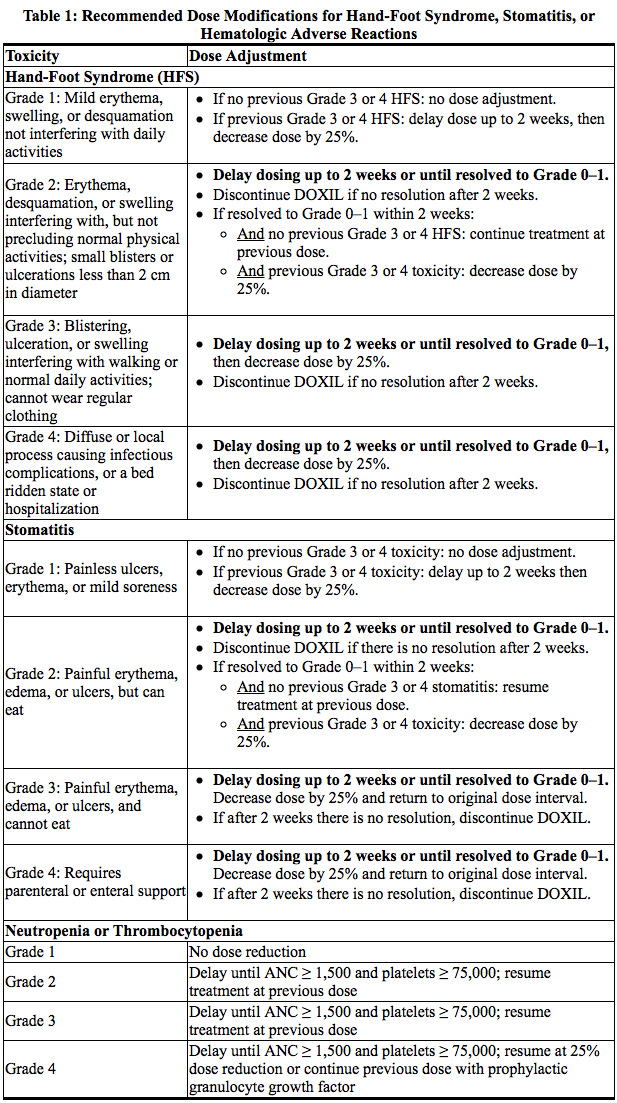
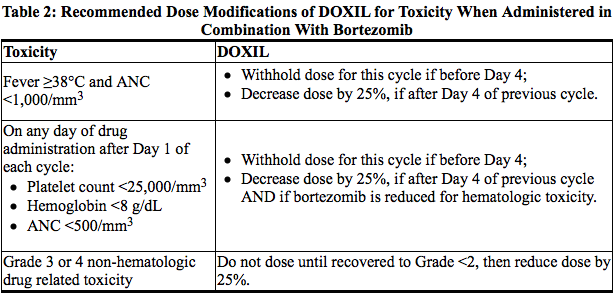
For neuropathic pain or peripheral neuropathy, no dosage adjustments are required for Doxil. Refer to bortezomib manufacturer's prescribing information.
Preparation and Administration
Preparation
Dilute Doxil doses up to 90 mg in 250 mL of 5% Dextrose Injection, USP prior to administration. Dilute doses exceeding 90 mg in 500 mL of 5% Dextrose Injection, USP prior to administration. Refrigerate diluted Doxil at 2°C to 8°C (36°F to 46°F) and administer within 24 hours.
Administration
Parenteral drug products should be inspected visually for particulate matter and discoloration prior to administration, whenever solution and container permit. Do not use if a precipitate or foreign matter is present.
Do not use with in-line filters.
Administer the first dose of Doxil at an initial rate of 1 mg/min. If no infusion-related adverse reactions are observed, increase the infusion rate to complete the administration of the drug over one hour. Do not rapidly flush the infusion line.
Do not mix Doxil with other drugs.
Management of Suspected Extravasation
Discontinue Doxil for burning or stinging sensation or other evidence indicating perivenous infiltration or extravasation. Manage confirmed or suspected extravasation as follows:
- Do not remove the needle until attempts are made to aspirate extravasated fluid
- Do not flush the line
- Avoid applying pressure to the site
- Apply ice to the site intermittently for 15 min 4 times a day for 3 days
- If the extravasation is in an extremity, elevate the extremity
Procedure for Proper Handling and Disposal
Handle and dispose of Doxil in accordance with recommendations for the handling and disposal of hazardous drugs.
If Doxil comes into contact with skin or mucosa, immediately wash thoroughly with soap and water.
Off-Label Use and Dosage (Adult)
Guideline-Supported Use
There is limited information regarding Off-Label Guideline-Supported Use of Doxorubicin liposome in adult patients.
Non–Guideline-Supported Use
Mycosis fungoides
- Dosing Information
- In observational, single-arm studies, pegylated liposomal DOXOrubicin 20 to 40 mg/m(2) IV every 4 weeks was administered for patients with refractory mycosis fungoides.[1][2]
Pediatric Indications and Dosage
FDA-Labeled Indications and Dosage (Pediatric)
The safety and effectiveness of Doxil in pediatric patients have not been established.
Off-Label Use and Dosage (Pediatric)
Guideline-Supported Use
There is limited information regarding Off-Label Guideline-Supported Use of Doxorubicin liposome in pediatric patients.
Non–Guideline-Supported Use
There is limited information regarding Off-Label Non–Guideline-Supported Use of Doxorubicin liposome in pediatric patients.
Contraindications
Doxil is contraindicated in patients who have a history of severe hypersensitivity reactions, including anaphylaxis, to doxorubicin HCl.
Warnings
Cardiomyopathy
Doxorubicin HCl can result in myocardial damage, including acute left ventricular failure. The risk of cardiomyopathy with doxorubicin HCl is generally proportional to the cumulative exposure. The relationship between cumulative Doxil dose and the risk of cardiac toxicity has not been determined.
In a clinical study in 250 patients with advanced cancer who were treated with Doxil, the risk of cardiotoxicity was 11% when the cumulative anthracycline dose was between 450–550 mg/m2. Cardiotoxicity was defined as >20% decrease in resting left ventricular ejection fraction (LVEF) from baseline where LVEF remained in the normal range or a >10% decrease in LVEF from baseline where LVEF was less than the institutional lower limit of normal. Two percent of patients developed signs and symptoms of congestive heart failure without documented evidence of cardiotoxicity.
Assess left ventricular cardiac function (e.g. MUGA or echocardiogram prior to initiation of Doxil, during treatment to detect acute changes, and after treatment to detect delayed cardiotoxicity. Administer Doxil to patients with a history of cardiovascular disease only when the potential benefit of treatment outweighs the risk.
Infusion-Related Reactions
Serious and sometimes life-threatening infusion-related reactions characterized by one or more of the following symptoms can occur with Doxil: flushing, shortness of breath facial swelling, headache, chills, chest pain, back pain, tightness in the chest and throat, fever, tachycardia, pruritus, rash, cyanosis, syncope, bronchospasm, asthma, apnea, and hypotension. The majority of infusion-related events occurred during the first infusion. Of 239 patients with ovarian cancer treated with Doxil in Trial 4, 7% of patients experienced acute infusion-related reactions resulting in dose interruption. All occurred during cycle 1 and none during subsequent cycles. Across multiple studies of Doxil monotherapy including this and other studies enrolling 760 patients with various solid tumors, 11% of patients had infusion-related reactions.
Ensure that medications to treat infusion-related reactions and cardiopulmonary resuscitative equipment is available for immediate use prior to initiation of Doxil. Initiate Doxil infusions at a rate of 1 mg/min and increase rate as tolerated. In the event of an infusion-related reaction, temporarily stop the drug until resolution then resume at a reduced infusion rate. Discontinue Doxil infusion for serious or life-threatening infusion-related reactions.
Hand-Foot Syndrome (HFS)
In Trial 4, the incidence of HFS was 51% of patients in the Doxil arm and 0.9% of patients in the topotecan arm, including 24% Grade 3 or 4 cases of HFS in Doxil-treated patients and no Grade 3 or 4 cases in topotecan-treated patients. HFS or other skin toxicity required discontinuation of Doxil in 4.2% of patients.
HFS was generally observed after 2 or 3 cycles of treatment but may occur earlier. Delay Doxil for the first episode of Grade 2 or greater HFS. Discontinue Doxil if HFS is severe and debilitating.
Secondary Oral Neoplasms
Secondary oral cancers, primarily squamous cell carcinoma, have been reported from post-marketing experience in patients with long-term (more than one year) exposure to Doxil. These malignancies were diagnosed both during treatment with Doxil and up to 6 years after the last dose. Examine patients at regular intervals for the presence of oral ulceration or with any oral discomfort that may be indicative of secondary oral cancer.
The altered pharmacokinetics and preferential tissue distribution of liposomal doxorubicin that contributes to enhanced skin toxicity and mucositis compared to free doxorubicin may play a role in the development of oral secondary malignancies with long-term use.
Embryofetal Toxicity
Based on animal data, Doxil can cause fetal harm when administered to a pregnant woman. At doses approximately 0.12 times the recommended clinical dose, Doxil was embryotoxic and abortifacient in rabbits. Advise pregnant women of the potential risk to a fetus. Advise females and males of reproductive potential to use effective contraception during and for 6 months after treatment with Doxil.
Adverse Reactions
Clinical Trials Experience
The most common adverse reactions (>20%) observed with Doxil are asthenia, fatigue, fever, nausea, stomatitis, vomiting, diarrhea, constipation, anorexia, hand-foot syndrome, rash and neutropenia, thrombocytopenia and anemia.
Adverse Reactions in Clinical Trials
Because clinical trials are conducted under widely varying conditions, the adverse reaction rates observed cannot be directly compared to rates on other clinical trials and may not reflect the rates observed in clinical practice.
The safety data reflect exposure to Doxil in 1310 patients including: 239 patients with ovarian cancer, 753 patients with AIDS-related Kaposi's sarcoma, and 318 patients with multiple myeloma.
The following tables present adverse reactions from clinical trials of single-agent Doxil in ovarian cancer and AIDS-Related Kaposi's sarcoma.
Patients With Ovarian Cancer
The safety data described below are from Trial 4, which included 239 patients with ovarian cancer treated with Doxil 50 mg/m2 once every 4 weeks for a minimum of four courses in a randomized, multicenter, open-label study. In this trial, patients received Doxil for a median number of 3.2 months (range 1 day to 25.8 months). The median age of the patients is 60 years (range 27 to 87), with 91% Caucasian, 6% Black, and 3% Hispanic or Other.
Table 3 presents the hematologic adverse reactions from Trial 4.
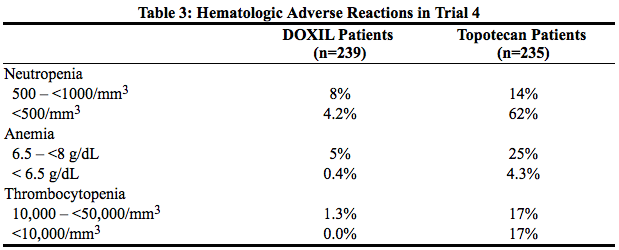
Table 4 presents the non-hematologic adverse reactions from Trial 4.
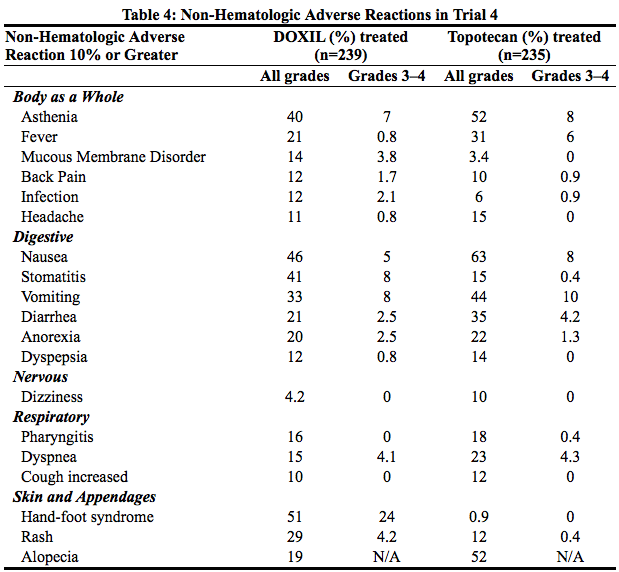
The following additional adverse reactions were observed in patients with ovarian cancer with doses administered every four weeks (Trial 4).
Incidence 1% to 10%
Cardiovascular: vasodilation, tachycardia, deep vein thrombosis, hypotension, cardiac arrest.
Digestive: oral moniliasis, mouth ulceration, esophagitis, dysphagia, rectal bleeding, ileus.
Hematologic and Lymphatic: ecchymosis.
Metabolic and Nutritional: dehydration, weight loss, hyperbilirubinemia, hypokalemia, hypercalcemia, hyponatremia.
Nervous: somnolence, dizziness, depression.
Respiratory: rhinitis, pneumonia, sinusitis, epistaxis.
Skin and Appendages: pruritus, skin discoloration, vesiculobullous rash, maculopapular rash, exfoliative dermatitis, herpes zoster, dry skin, herpes simplex, fungal dermatitis, furunculosis, acne.
Special Senses: conjunctivitis, taste perversion, dry eyes.
Urinary: urinary tract infection, hematuria, vaginal moniliasis.
Patients With AIDS-Related Kaposi's Sarcoma
The safety data described is based on the experience reported in 753 patients with AIDS-related Kaposi's sarcoma (KS) enrolled in four open-label, uncontrolled trials of Doxil administered at doses ranging from 10 to 40 mg/m2 every 2 to 3 weeks. Demographics of the population were: median age 38.7 years (range 24–70); 99% male; 88% Caucasian, 6% Hispanic, 4% Black, and 2% Asian/other/unknown. The majority of patients were treated with 20 mg/m2 of Doxil every 2 to 3 weeks with a median exposure of 4.2 months (range 1 day to 26.6 months). The median cumulative dose was 120 mg/m2 (range 3.3 to 798.6 mg/m2); 3% received cumulative doses of greater than 450 mg/m2.
Disease characteristics were: 61% poor risk for KS tumor burden, 91% poor risk for immune system, and 47% poor risk for systemic illness; 36% were poor risk for all three categories; median CD4 count 21 cells/mm3 (51% less than 50 cells/mm3); mean absolute neutrophil count at study entry approximately 3,000 cells/mm3.
Of the 693 patients with concomitant medication information, 59% were on one or more antiretroviral medications [35% zidovudine (AZT), 21% didanosine (ddI), 16% zalcitabine (ddC), and 10% stavudine (D4T)]; 85% received PCP prophylaxis (54% sulfamethoxazole/trimethoprim); 85% received antifungal medications (76% fluconazole); 72% received antivirals (56% acyclovir, 29% ganciclovir, and 16% foscarnet) and 48% patients received colony-stimulating factors (sargramostim/filgrastim) during their course of treatment.
Adverse reactions led to discontinuation of treatment in 5% of patients with AIDS-related Kaposi's sarcoma and included myelosuppression, cardiac adverse reactions, infusion-related reactions, toxoplasmosis, HFS, pneumonia, cough/dyspnea, fatigue, optic neuritis, progression of a non-KS tumor, allergy to penicillin, and unspecified reasons. Tables 5 and 6 summarize adverse reactions reported in patients treated with Doxil for AIDS-related Kaposi's sarcoma in a pooled analysis of the four trials.
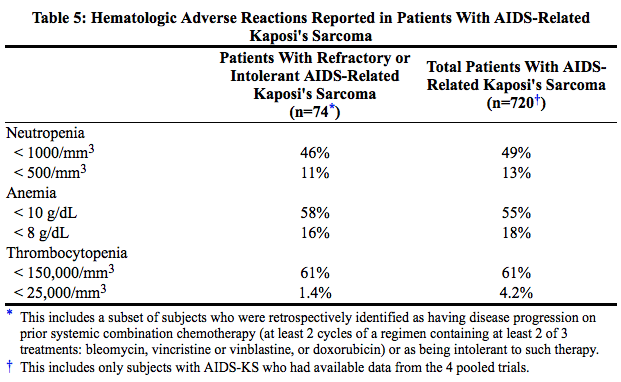
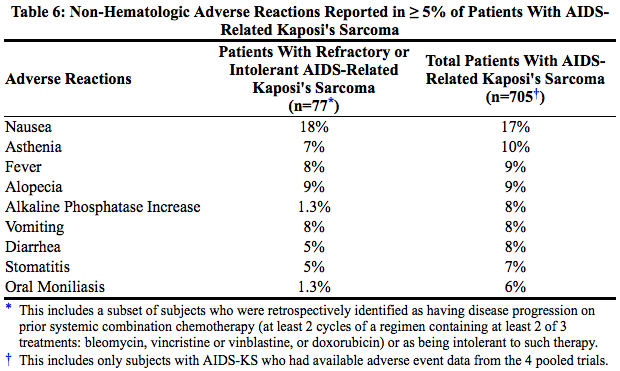
The following additional adverse reactions were observed in 705 patients with AIDS-related Kaposi's sarcoma.
Incidence 1% to 5%
Body as a Whole: headache, back pain, infection, allergic reaction, chills.
Cardiovascular: chest pain, hypotension, achycardia.
Cutaneous: herpes simplex, rash, itching.
Digestive: mouth ulceration, anorexia, dysphagia.
Metabolic and Nutritional: SGPT increase, weight loss, hyperbilirubinemia.
Other: dyspnea, pneumonia, dizziness, somnolence.
Incidence Less Than 1%
Body As A Whole: sepsis, moniliasis, cryptococcosis.
Cardiovascular: thrombophlebitis, cardiomyopathy, palpitation, bundle branch block, congestive heart failure, heart arrest, thrombosis, ventricular arrhythmia.
Digestive: hepatitis.
Metabolic and Nutritional Disorders: dehydration
Respiratory: cough increase, pharyngitis.
Skin and Appendages: maculopapular rash, herpes zoster.
Special Senses: taste perversion, conjunctivitis.
Patients With Multiple Myeloma
The safety data described are from 318 patients treated with Doxil (30 mg/m2) administered on day 4 following bortezomib (1.3 mg/m2 i.v. bolus on days 1, 4 , 8 and 11) every 3 weeks, in a randomized, open-label, multicenter study (Trial 6). In this trial, patients in the Doxil + bortezomib combination group were treated for a median number of 4.5 months (range 21 days to 13.5 months). The population was 28 to 85 years of age (median age 61), 58% male, 90% Caucasian, 6% Black, and 4% Asian and Other. Table 7 lists adverse reactions reported in 10% or more of patients treated with Doxil in combination with bortezomib for multiple myeloma.

Postmarketing Experience
The following additional adverse reactions have been identified during post approval use of Doxil. Because these reactions are reported voluntarily from a population of uncertain size, it is not always possible to reliably estimate their frequency or establish a causal relationship to drug exposure.
Musculoskeletal and Connective Tissue Disorders: muscle spasms
Respiratory, Thoracic and Mediastinal Disorders: pulmonary embolism (in some cases fatal)
Hematologic disorders: Secondary acute myelogenous leukemia
Skin and subcutaneous tissue disorders: erythema multiforme, Stevens-Johnson syndrome, toxic epidermal necrolysis
Drug Interactions
No formal drug interaction studies have been conducted with Doxil.
Use in Specific Populations
Pregnancy
Risk Summary
Based on findings in animals, Doxil can cause fetal harm when administered to a pregnant woman. In animal reproduction studies, Doxil was embryotoxic in rats and abortifacient in rabbits following intravenous administration during organogenesis at doses approximately 0.12 times the recommended clinical dose. There are no available human data informing the drug-associated risk. Advise pregnant women of the potential risk to a fetus.
The background risk of major birth defects and miscarriage for the indicated populations are unknown. However, the background risk in the U.S. general population of major birth defects is 2–4% and of miscarriage is 15–20% of clinically recognized pregnancies.
Animal Data
Doxil was embryotoxic at doses of 1 mg/kg/day in rats and was embryotoxic and abortifacient at 0.5 mg/kg/day in rabbits (both doses are about 0.12 times the recommended dose of 50 mg/m2 human dose on a mg/m2 basis). Embryotoxicity was characterized by increased embryo-fetal deaths and reduced live litter sizes.
Labor and Delivery
There is no FDA guidance on use of Doxorubicin liposome during labor and delivery.
Nursing Mothers
It is not known whether Doxil is present in human milk. Because many drugs, including anthracyclines, are excreted in human milk and because of the potential for serious adverse reactions in nursing infants from Doxil, discontinue breastfeeding during treatment with Doxil.
Pediatric Use
The safety and effectiveness of Doxil in pediatric patients have not been established.
Geriatic Use
Clinical studies of Doxil conducted in patients with either epithelial ovarian cancer (Trial 4) or with AIDS-related Kaposi's sarcoma (Trial 5) did not contain sufficient numbers of patients aged 65 and over to determine whether they respond differently from younger subjects.
In Trial 6, of 318 patients treated with Doxil in combination with bortezomib for multiple myeloma, 37% were 65 years of age or older and 8% were 75 years of age or older. No overall differences in safety or efficacy were observed between these patients and younger patients.
Gender
Contraception
Females
Doxil can cause fetal harm when administered to a pregnant woman. Advise females of reproductive potential to use effective contraception during and for 6 months after treatment with Doxil.
Males
Doxil may damage spermatozoa and testicular tissue, resulting in possible genetic fetal abnormalities. Males with female sexual partners of reproductive potential should use effective contraception during and for 6 months after treatment with Doxil.
Infertility
Females
In females of reproductive potential, Doxil may cause infertility and result in amenorrhea. Premature menopause can occur with doxorubicin HCl. Recovery of menses and ovulation is related to age at treatment.
Males
Doxil may result in oligospermia, azoospermia, and permanent loss of fertility. Sperm counts have been reported to return to normal levels in some men. This may occur several years after the end of therapy.
Race
There is no FDA guidance on the use of Doxorubicin liposome with respect to specific racial populations.
Renal Impairment
There is no FDA guidance on the use of Doxorubicin liposome in patients with renal impairment.
Hepatic Impairment
The pharmacokinetics of Doxil has not been adequately evaluated in patients with hepatic impairment. Doxorubicin is eliminated in large part by the liver. Reduce Doxil for serum bilirubin of 1.2 mg/dL or higher.
Females of Reproductive Potential and Males
There is no FDA guidance on the use of Doxorubicin liposome in women of reproductive potentials and males.
Immunocompromised Patients
There is no FDA guidance one the use of Doxorubicin liposome in patients who are immunocompromised.
Administration and Monitoring
Administration
Intravenous
Monitoring
There is limited information regarding Monitoring of Doxorubicin liposome in the drug label.
Overdosage
Acute overdosage with doxorubicin HCl causes increased risk of severe mucositis, leukopenia, and thrombocytopenia.
Pharmacology
Mechanism of Action
The active ingredient of Doxil is doxorubicin HCl. The mechanism of action of doxorubicin HCl is thought to be related to its ability to bind DNA and inhibit nucleic acid synthesis. Cell structure studies have demonstrated rapid cell penetration and perinuclear chromatin binding, rapid inhibition of mitotic activity and nucleic acid synthesis, and induction of mutagenesis and chromosomal aberrations.
Structure
Doxil (doxorubicin HCl liposome injection) is doxorubicin hydrochloride (HCl), an anthracycline topoisomerase II inhibitor, that is encapsulated in STEALTH® liposomes for intravenous use.
The chemical name of doxorubicin HCl is (8S,10S)-10-[(3-amino-2,3,6-trideoxy-α-L-lyxo-hexopyranosyl)oxy]-8-glycolyl-7,8,9,10-tetrahydro-6,8,11-trihydroxy-1-methoxy-5,12-naphthacenedione hydrochloride. The molecular formula is C27-H29 -NO11∙HCl; its molecular weight is 579.99.
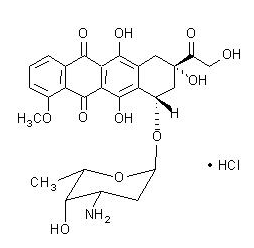
Doxil is a sterile, translucent, red liposomal dispersion in 10-mL or 30-mL glass, single use vials. Each vial contains 20 mg or 50 mg doxorubicin HCl at a concentration of 2 mg/mL and a pH of 6.5. The STEALTH liposome carriers are composed of cholesterol, 3.19 mg/mL; fully hydrogenated soy phosphatidylcholine (HSPC), 9.58 mg/mL; and N-(carbonyl-methoxypolyethylene glycol 2000)-1,2-distearoyl-sn-glycero-3-phosphoethanolamine sodium salt (MPEG-DSPE), 3.19 mg/mL. Each mL also contains ammonium sulfate, approximately 2 mg; histidine as a buffer; hydrochloric acid and/or sodium hydroxide for pH control; and sucrose to maintain isotonicity. Greater than 90% of the drug is encapsulated in the STEALTH liposomes.
MPEG-DSPE has the following structural formula:

HSPC has the following structural formula:
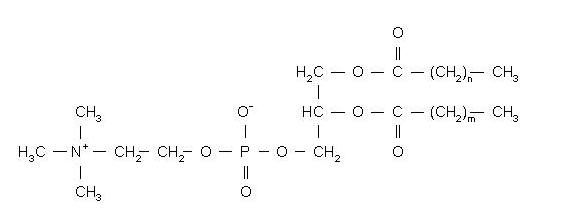
Representation of a STEALTH liposome:
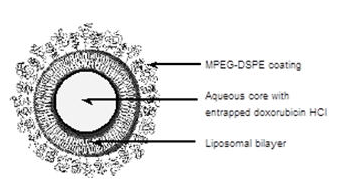
Pharmacodynamics
There is limited information regarding Pharmacodynamics of Doxorubicin liposome in the drug label.
Pharmacokinetics
The pharmacokinetic parameters for total doxorubicin following a single dose of Doxil infused over 30 minutes are presented in Table 8.
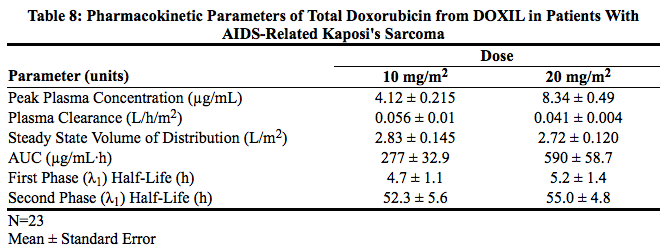
Doxil displayed linear pharmacokinetics over the range of 10 to 20 mg/m2. Relative to Doxil doses at or below 20 mg/m2, the pharmacokinetics of total doxorubicin following a 50 mg/m2 Doxil dose are nonlinear. At this dose, the elimination half-life of Doxil is longer and the clearance lower compared to a 20 mg/m2 dose.
Distribution:
Direct measurement of liposomal doxorubicin shows that at least 90% of the drug (the assay used cannot quantify less than 5–10% free doxorubicin) remains liposome-encapsulated during circulation.
In contrast to doxorubicin, which displays a large volume of distribution (range 700 to 1100 L/m2), the small steady state volume of distribution of liposomal doxorubicin suggests that Doxil is largely confined to vascular fluid. Doxorubicin becomes available after the liposomes are extravasated. Plasma protein binding of Doxil has not been determined; the plasma protein binding of doxorubicin is approximately 70%.
Metabolism:
Doxorubicinol, the major metabolite of doxorubicin, was detected at concentrations of 0.8 to 26.2 ng/mL in the plasma of patients who received 10 or 20 mg/m2 Doxil.
Elimination:
The plasma clearance of total doxorubicin from Doxil was 0.041 L/h/m2 at a dose of 20 mg/m2. Following administration of doxorubicin HCl, the plasma clearance of doxorubicin is 24 to 35 L/h/m2.`
Nonclinical Toxicology
Carcinogenesis, Mutagenesis, and Impairment of Fertility
Mutagenicity or carcinogenicity studies have not been conducted with Doxil, however doxorubicin was shown to be mutagenic in the in vitro Ames assay, and clastogenic in multiple in vitro assays (CHO cell, V79 hamster cell, human lymphoblast, and SCE assays) and the in vivo mouse micronucleus assay. The possible adverse effects on fertility in animals have not been adequately evaluated. Doxil resulted in mild to moderate ovarian and testicular atrophy in mice after administration of a single dose of 36 mg/kg (about 2 times the 50 mg/m2 human dose on a mg/m2 basis). Decreased testicular weights and hypospermia were observed in rats after repeat doses ≥ 0.25 mg/kg/day (about 0.03 times the 50 mg/m2 human dose on a mg/m2 basis), and diffuse degeneration of the seminiferous tubules and a marked decrease in spermatogenesis were observed in dogs after repeat doses of 1 mg/kg/day (about 0.4 times the 50 mg/m2 human dose on a mg/m2 basis).
Clinical Studies
Ovarian Cancer
Doxil was studied in three open-label, single-arm, clinical studies of 176 patients with metastatic ovarian cancer (Trials 1, 2, and 3). One hundred forty-five of these patients were refractory to both paclitaxel- and platinum-based chemotherapy regimens, defined as disease progression while on treatment or relapse within 6 months of completing treatment. Patients received Doxil at 50 mg/m2 every 3 or 4 weeks for 3–6+ cycles in the absence of dose-limiting toxicity or disease progression.
The median age at diagnosis ranged from 52 to 64 years in the 3 studies, and the range was 22 to 85. Most patients had International Federation of Obstetricians and Gynecologists (FIGO) stage III or IV disease (ranging from 83% to 93%). Approximately one third of the patients had three or more prior lines of therapy (ranging from 22% to 33%).
The primary outcome measure was confirmed response rate based on Southwestern Oncology Group (SWOG) criteria for patients refractory to both paclitaxel- and a platinum-containing regimen. Secondary efficacy parameters were time to response, duration of response, and time to progression.
The response rates for the individual single arm trials are given in Table 9 below.

In a pooled analysis of Trials 1–3, the response rate for all patients refractory to paclitaxel and platinum agents was 13.8% (95% CI 8.1% to 19.3%). The median time to progression was 15.9 weeks, the median time to response was 17.6 weeks, and the duration of response was 39.4 weeks.
In Trial 4, a randomized, multicenter, open-label, trial in 474 patients with epithelial ovarian cancer after platinum-based chemotherapy, patients were randomized to receive either Doxil 50 mg/m2 every 4 weeks (n=239) or topotecan 1.5 mg/m2 daily for 5 consecutive days every 3 weeks (n=235). Patients were stratified according to platinum sensitivity (response to initial platinum-based therapy and a progression-free interval of greater than 6 months off treatment) and the presence of bulky disease (tumor mass greater than 5 cm in size). The primary outcome measure was time to progression (TTP). Other endpoints included overall survival and objective response rate.
Of the 474 patients, the median age at diagnosis was 60 years (range 25 to 87), 90% were FIGO stage III and IV; 46% were platinum sensitive; and 45% had bulky disease.
There was no statistically significant difference in TTP between the two arms. Results are provided in Table 10.
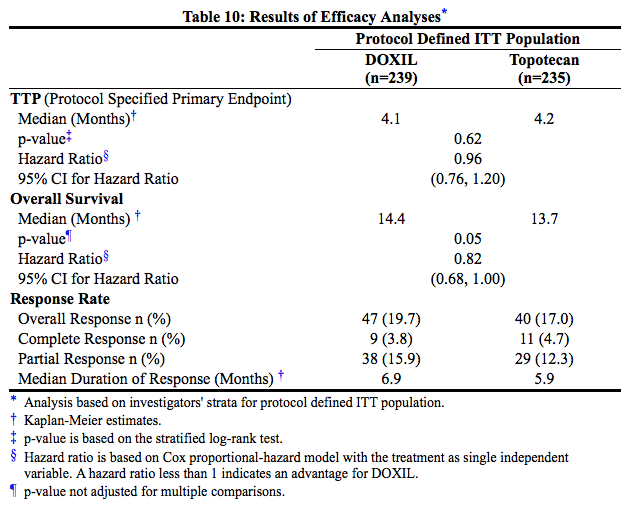
AIDS-Related Kaposi's Sarcoma
Doxil was studied in an open-label, single-arm, multicenter study at a dose of 20 mg/m2 every 3 weeks, until disease progression or unacceptable toxicity (Trial 5).
Data is described for a cohort of 77 patients retrospectively identified as having disease progression on prior systemic combination chemotherapy (at least two cycles of a regimen containing at least two of three treatments: bleomycin, vincristine or vinblastine, or doxorubicin) or as being intolerant to such therapy. Forty-nine of the 77 (64%) patients had received prior doxorubicin HCl.
The median time on study was 5.1 months (range 1 day to 15 months). The median cumulative dose of Doxil was 154 mg/m2 (range 20 to 620 mg/m2). Among the 77 patients, mean age was 38 years (range 24 to 54); 87% were Caucasian, 5% Hispanic, 4% Black, and 4% Asian/Other/Unknown; median CD4 count was 10 cells/mm3; ACTG staging criteria were 78% poor risk for tumor burden, 96% poor risk for immune system, and 58% poor risk for systemic illness at baseline; and mean Karnofsky status score was 74%. All patients had cutaneous or subcutaneous lesions, 40% also had oral lesions, 26% pulmonary lesions, and 14% had lesions of the stomach/intestine.
Two analyses of tumor response were used: one based on investigator assessment of changes in lesions based on modified ACTG criteria (partial response defined as no new lesions, sites of disease, or worsening edema; flattening of ≥50% of previously raised lesions or area of indicator lesions decreasing by ≥50%; and response lasting at least 21 days with no prior progression), and one based on changes in up to five prospectively indentified representative indicator lesions (partial response defined as flattening of ≥50% of previously raised indicator lesions, or >50% decrease in the area of indicator lesions and lasting at least 21 days with no prior progression).
Of the 77 patients, 34 were evaluable for investigator assessment and 42 were evaluable for indicator lesion assessment; analyses of tumor responses are shown in Table 11.
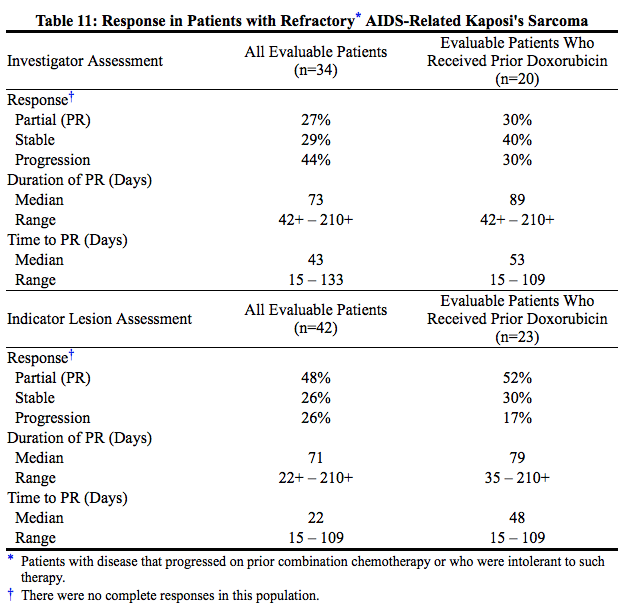
Retrospective efficacy analyses were performed in two trials that had subsets of patients who received single-agent Doxil and who were on stable antiretroviral therapy for at least 60 days prior to enrollment and until a response was demonstrated. In one trial, 7 of 17 (40%) patients had a durable response (median duration not reached but was longer than 11.6 months). In the second trial, 4 of 11 patients (40%) on a stable antiretroviral therapy demonstrated durable responses.
Multiple Myeloma
The efficacy of Doxil in combination with bortezomib was evaluated in Trial 6, a randomized, open-label, international, multicenter study in 646 patients who had not previously received bortezomib and whose disease progressed during or after at least one prior therapy. Patients were randomized (1:1) to receive either Doxil (30 mg/m2) administered IV on day 4 following bortezomib (1.3 mg/m2 IV on days 1, 4 , 8 and 11) or bortezomib alone every 3 weeks for up to 8 cycles or until disease progression or unacceptable toxicity. Patients who maintained a response were allowed to receive further treatment. The median number of cycles in each treatment arm was 5 (range 1–18).
The baseline demographics and clinical characteristics of the patients with multiple myeloma were similar between treatment arms (Table 12).
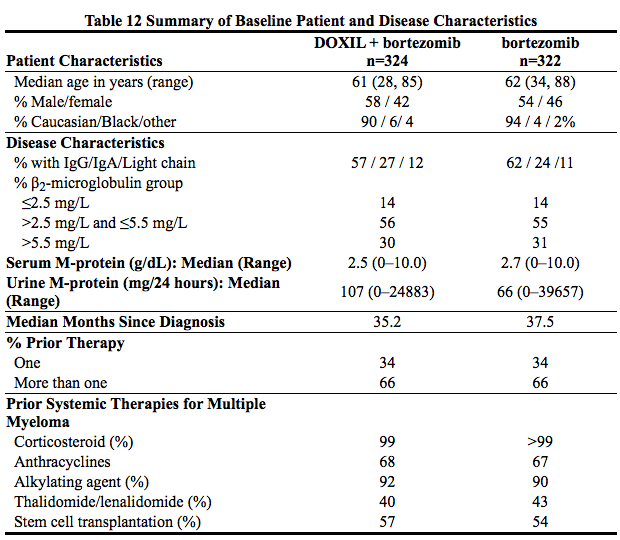
The primary outcome measure was time to progression (TTP). TTP was defined as the time from randomization to the first occurrence of progressive disease or death due to progressive disease. The combination arm demonstrated significant improvement in TTP. As the prespecified primary objective was achieved at the interim analysis, patients in the bortezomib monotherapy group were then allowed to receive the Doxil + bortezomib combination. Survival continued to be followed after the interim analysis and survival data are not mature at this time. Efficacy results are as shown in Table 13 and Figure 1.
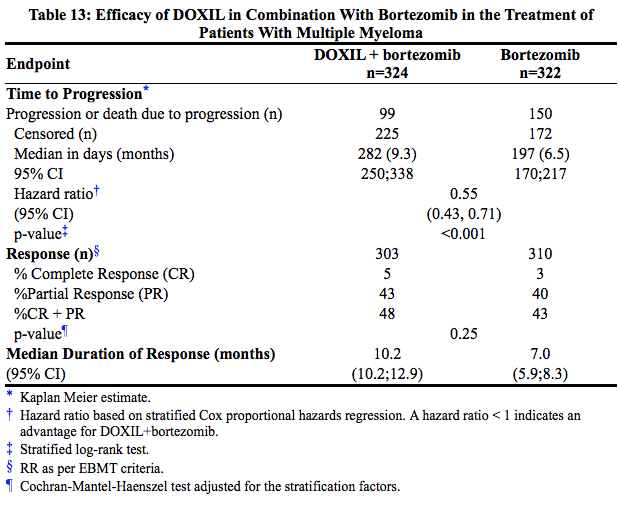
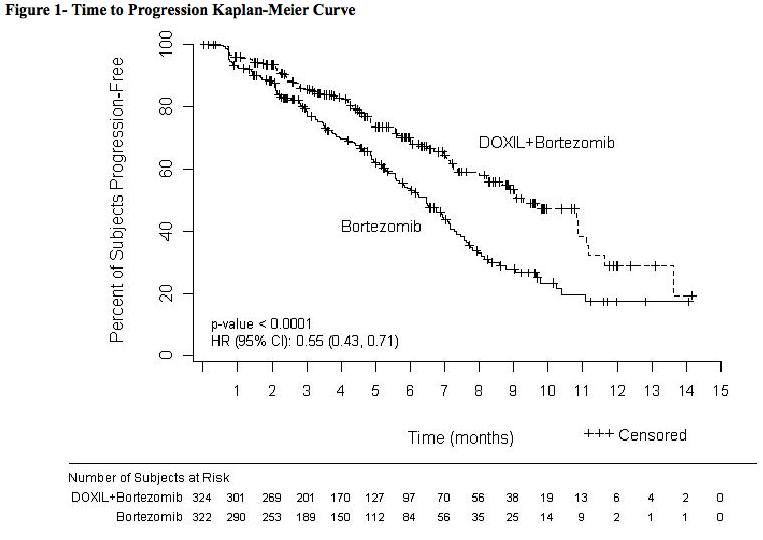
How Supplied
Doxil is a sterile, translucent, red liposomal dispersion in 10-mL or 30-mL glass, single use vials.
Each 10-mL vial contains 20 mg doxorubicin HCl at a concentration of 2 mg/mL.
Each 30-mL vial contains 50 mg doxorubicin HCl at a concentration of 2 mg/mL.
The following individually cartoned vials are available:

Images
Package and Label Display Panel
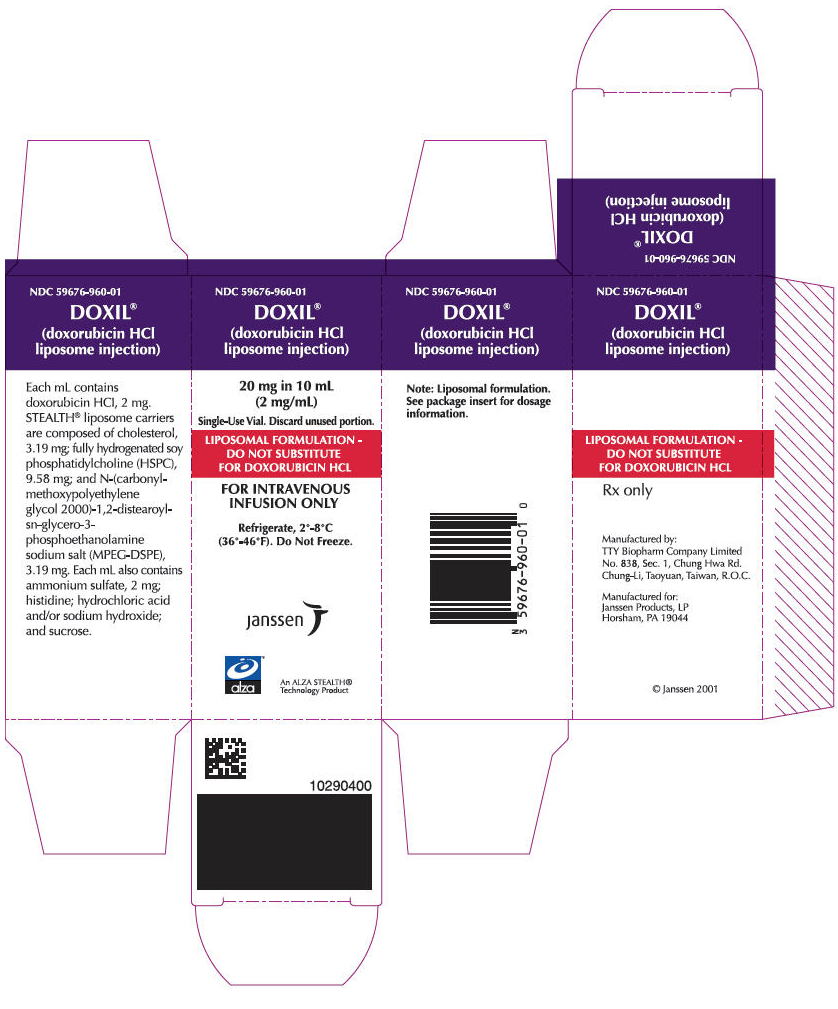
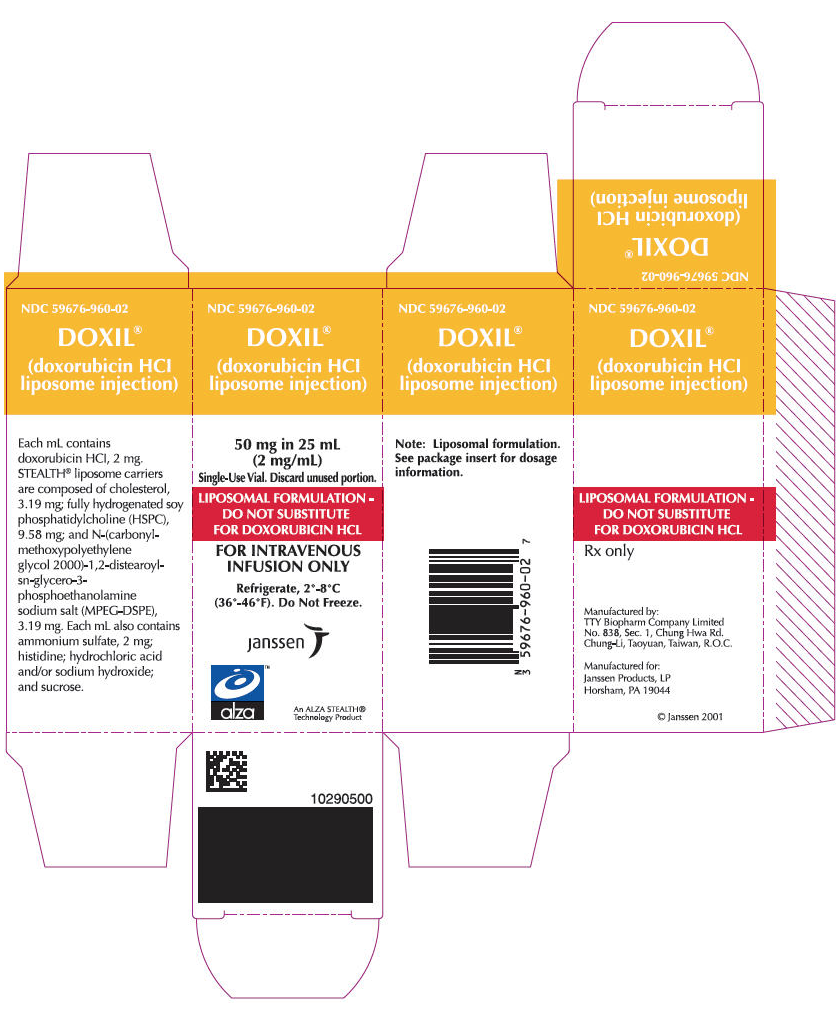
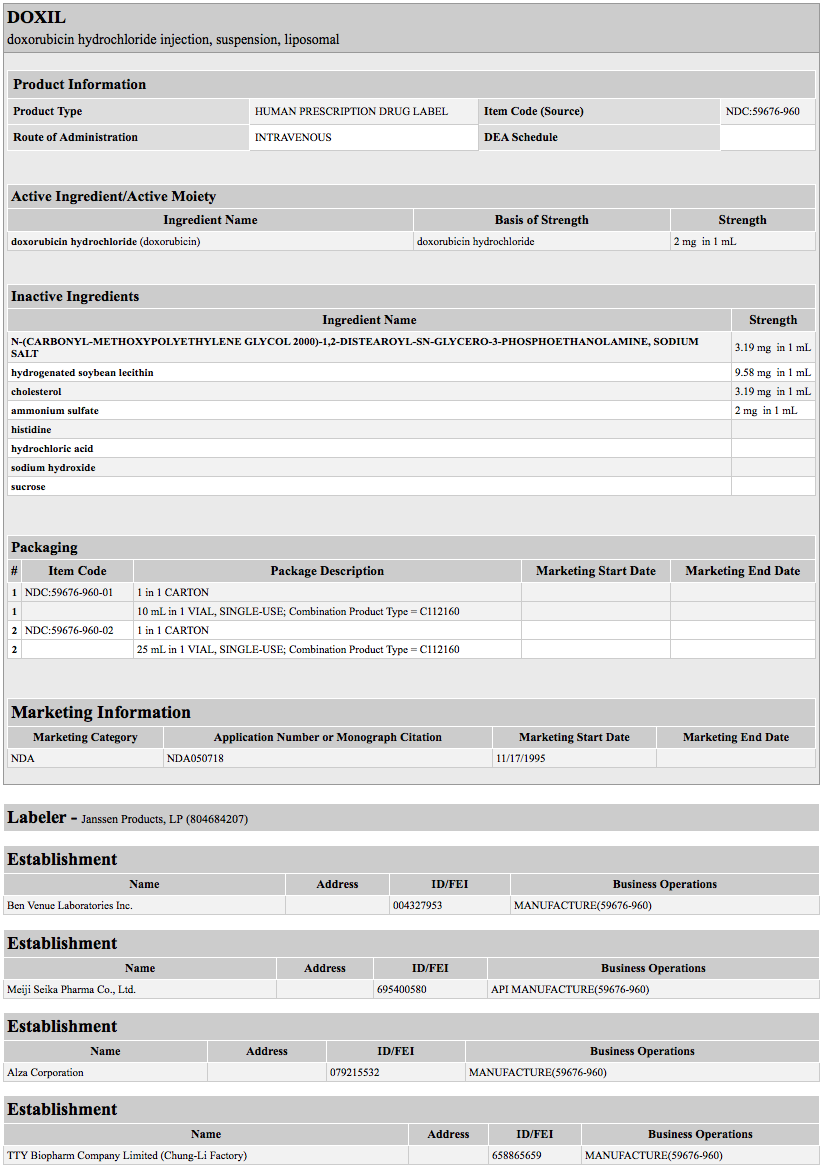
Patient Counseling Information
Cardiomyopathy
Advise patients to contact their healthcare provider if they develop symptoms of heart failure.
Infusion-Related Reactions
Advise patients about the symptoms of infusion related reactions and to seek immediate medical attention if they develop any of these symptoms.
Myelosuppression
Advise patients to contact their healthcare provider for a new onset fever or symptoms of infection.
Hand-Foot Syndrome
Advise patients to notify their healthcare provider if they experience tingling or burning, redness, flaking, bothersome swelling, small blisters, or small sores on the palms of their hands or soles of their feet (symptoms of Hand-Foot Syndrome).
Stomatitis
Advise patients to notify their healthcare provider if they develop painful redness, swelling, or sores in the mouth (symptoms of stomatitis).
Embryofetal Toxicity
Advise females of reproductive potential of the potential risk to a fetus and to inform their healthcare provider with a known or suspected pregnancy.
Advise females and males of reproductive potential to use effective contraception during and for 6 months following treatment with Doxil.
Lactation
Advise females not to breastfeed during treatment with Doxil.
Infertility
Advise females and males of reproductive potential that Doxil may cause temporary or permanent infertility.
Discoloration of Urine and Body Fluids
Inform patients that following Doxil administration, a reddish-orange color to the urine and other body fluids may be observed. This nontoxic reaction is due to the color of the product and will dissipate as the drug is eliminated from the body.
Precautions with Alcohol
Alcohol-Doxorubicin liposome interaction has not been established. Talk to your doctor about the effects of taking alcohol with this medication.
Brand Names
- Doxil ®[5]
- Lipodox
Look-Alike Drug Names
Drug Shortage Status
References
The contents of this FDA label are provided by the National Library of Medicine.
- ↑ Pulini, Stefano; Rupoli, Serena; Goteri, Gaia; Pimpinelli, Nicola; Alterini, Renato; Tassetti, Angela; Scortechini, Anna Rita; Offidani, Massimo; Mulattieri, Simonetta; Stronati, Andrea; Brandozzi, Giuliano; Giacchetti, Alfredo; Mozzicafreddo, Giorgio; Ricotti, Giuseppe; Filosa, Giorgio; Bettacchi, Alberta; Simonacci, Marco; Novelli, Nicolino; Leoni, Pietro (2007-05). "Pegylated liposomal doxorubicin in the treatment of primary cutaneous T-cell lymphomas". Haematologica. 92 (5): 686–689. ISSN 1592-8721. PMID 17488695. Check date values in:
|date=(help) - ↑ Quereux, Gaëlle; Marques, Sonia; Nguyen, Jean-Michel; Bedane, Christophe; D'incan, Michel; Dereure, Olivier; Puzenat, Elisabeth; Claudy, Alain; Martin, Ludovic; Joly, Pascal; Delaunay, Michele; Beylot-Barry, Marie; Vabres, Pierre; Celerier, Philippe; Sasolas, Bruno; Grange, Florent; Khammari, Amir; Dreno, Brigitte (2008-06). "Prospective multicenter study of pegylated liposomal doxorubicin treatment in patients with advanced or refractory mycosis fungoides or Sézary syndrome". Archives of Dermatology. 144 (6): 727–733. doi:10.1001/archderm.144.6.727. ISSN 1538-3652. PMID 18559761. Check date values in:
|date=(help) - ↑ 3.0 3.1 3.2 "(doxorubicin) dosing, indications, interactions, adverse effects, and more". Medscape Reference. WebMD. Retrieved 15 April 2014.
- ↑ Brayfield, A, ed. (19 December 2013). "Doxorubicin". Martindale: The Complete Drug Reference. Pharmaceutical Press. Retrieved 15 April 2014.
- ↑ "DOXIL- doxorubicin hydrochloride injection, suspension, liposomal".

